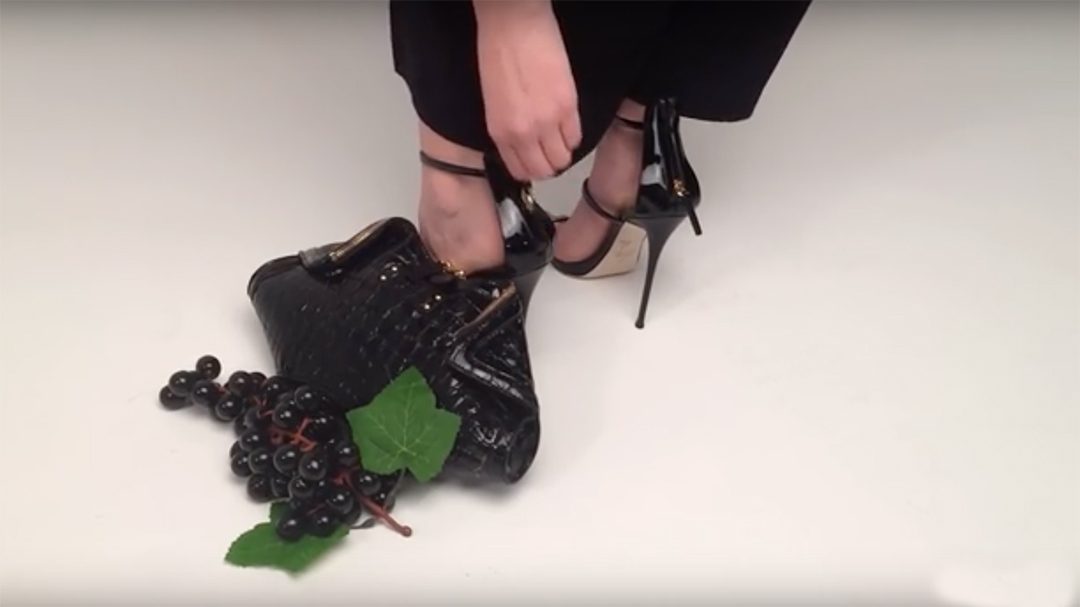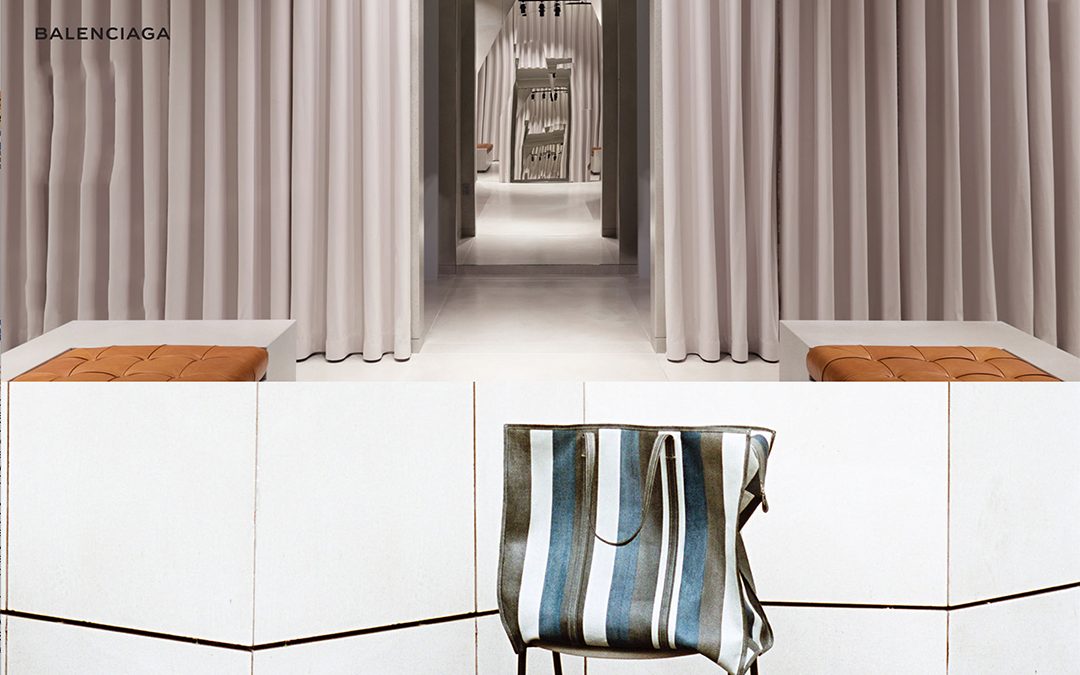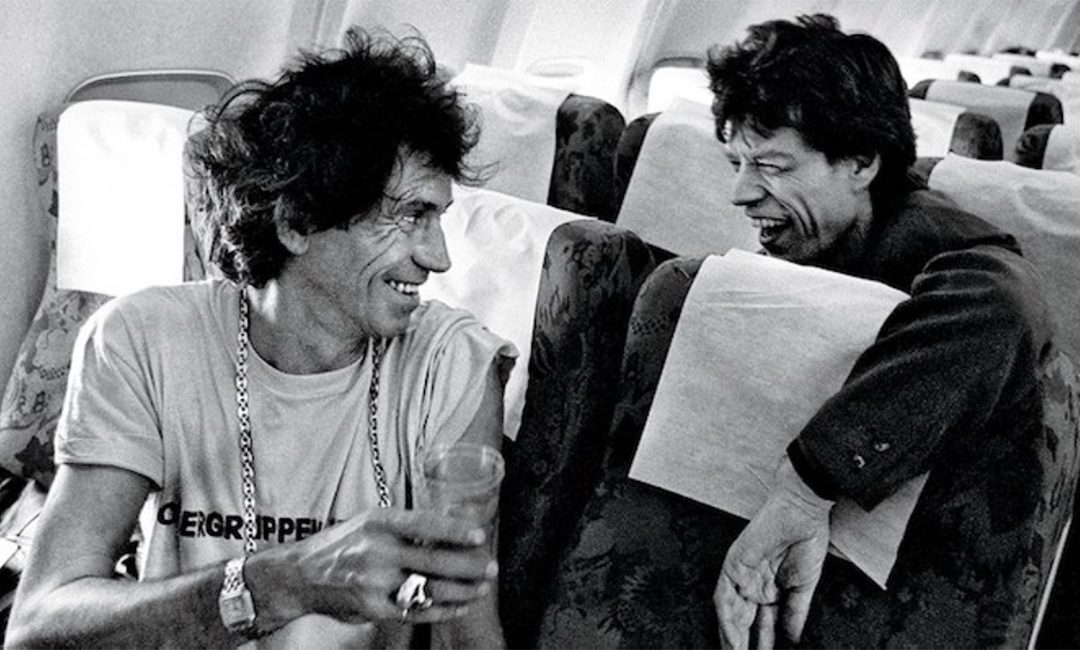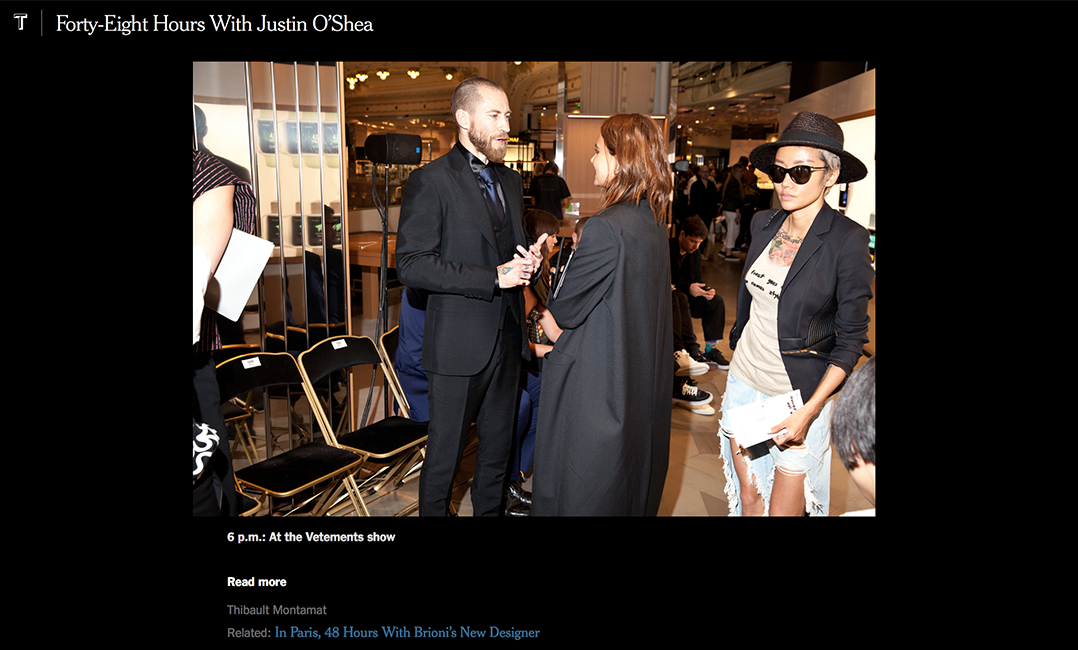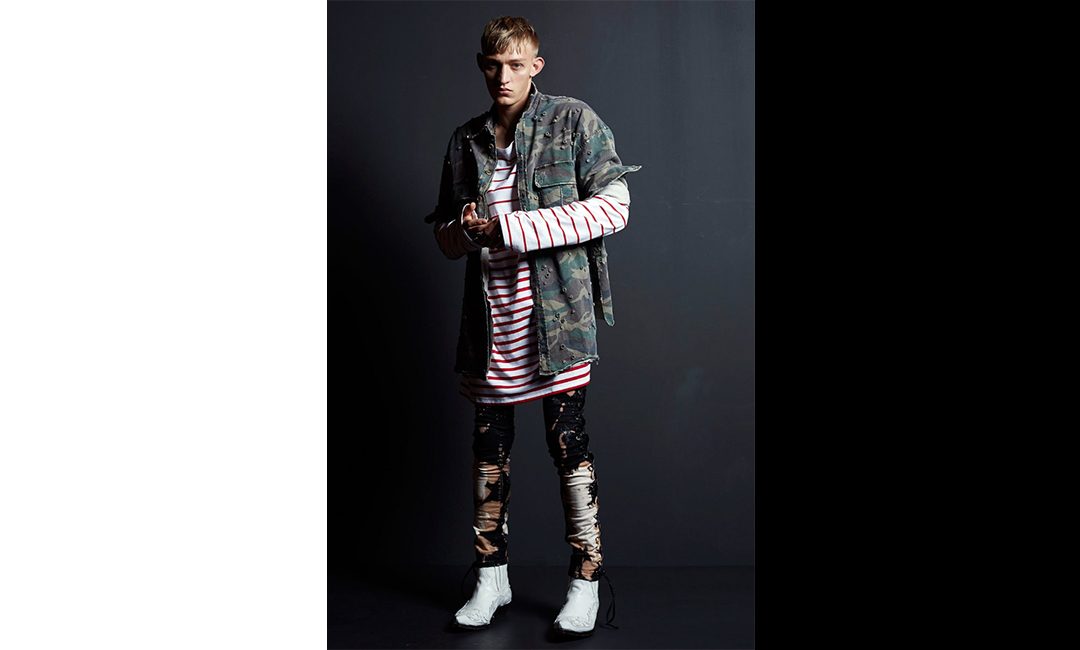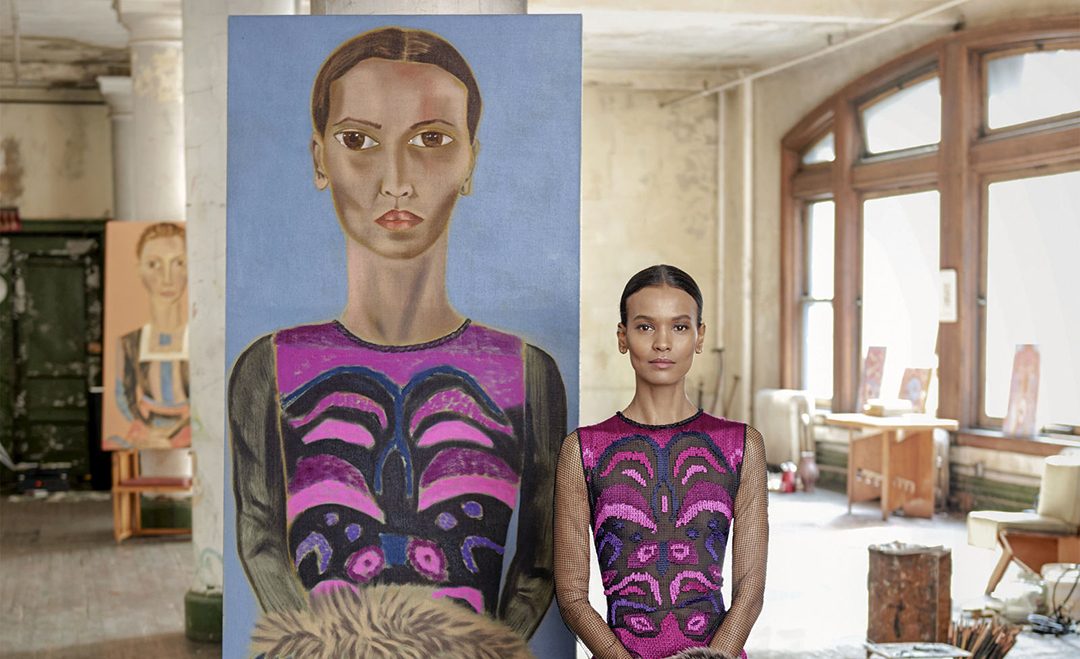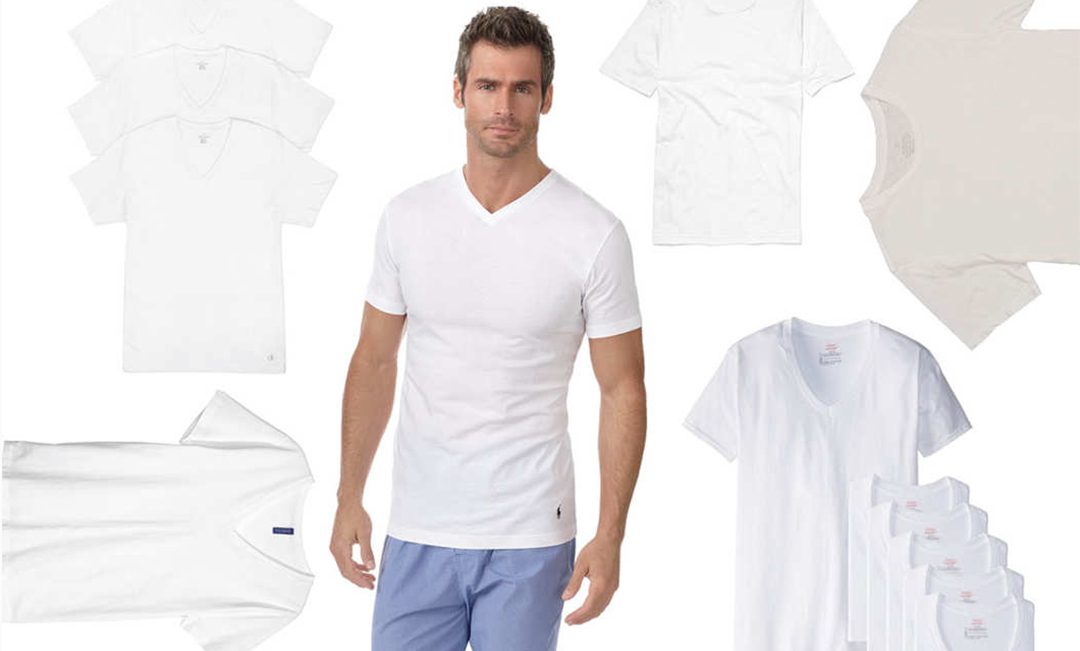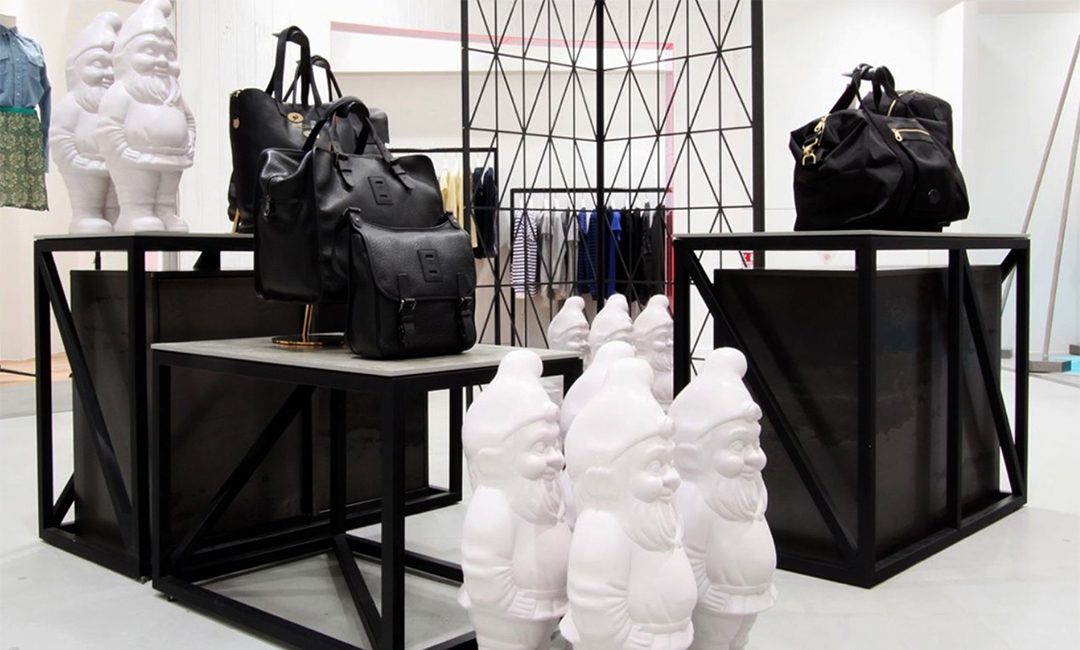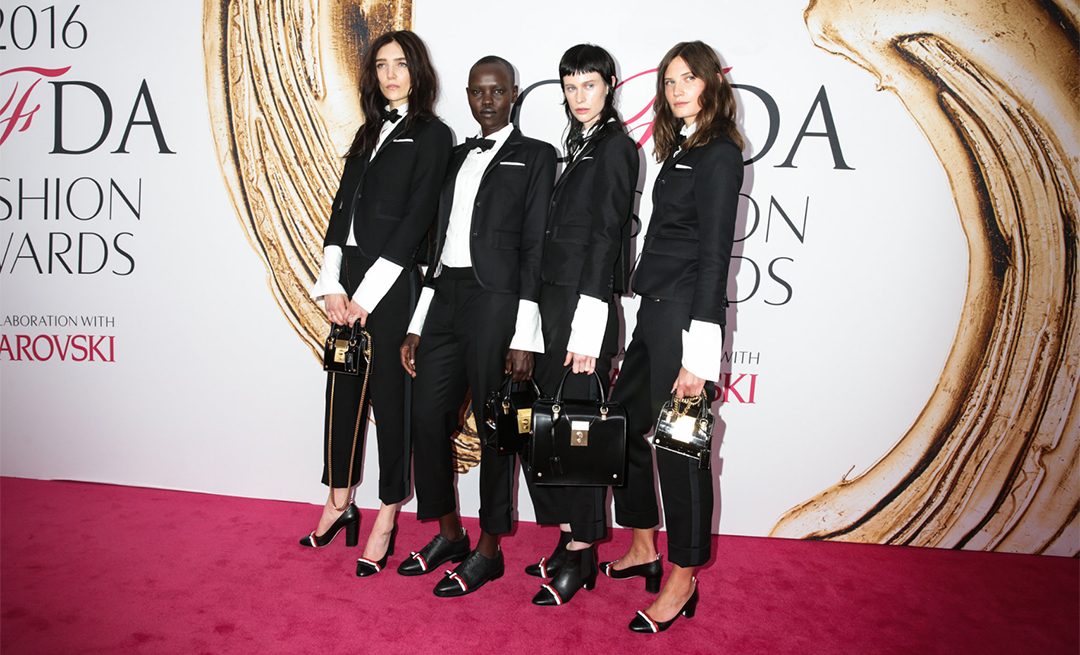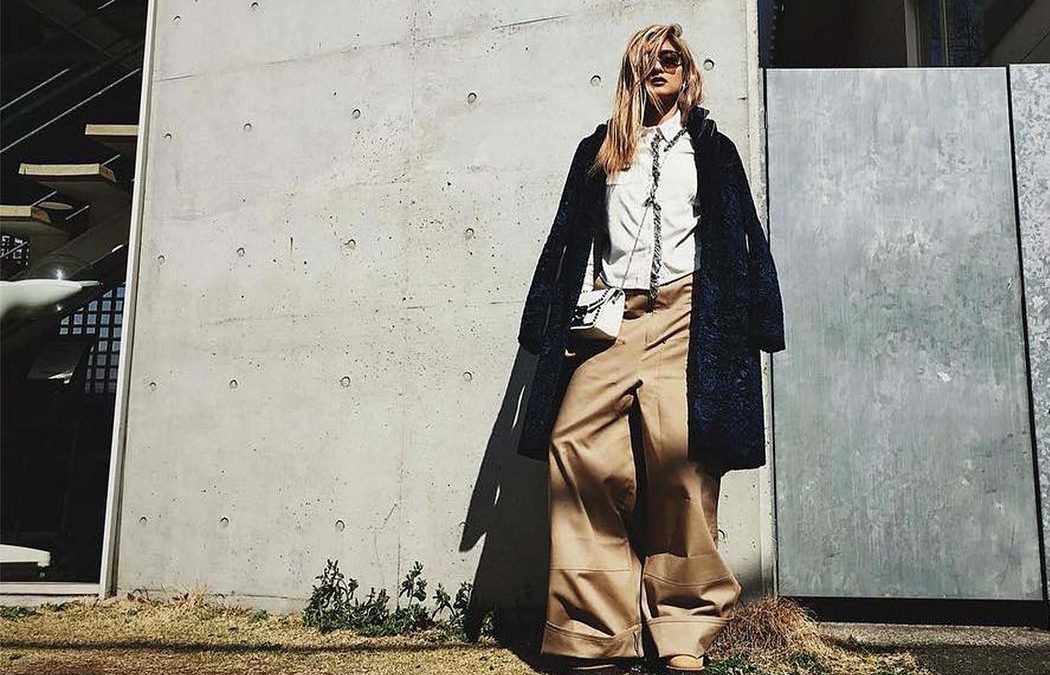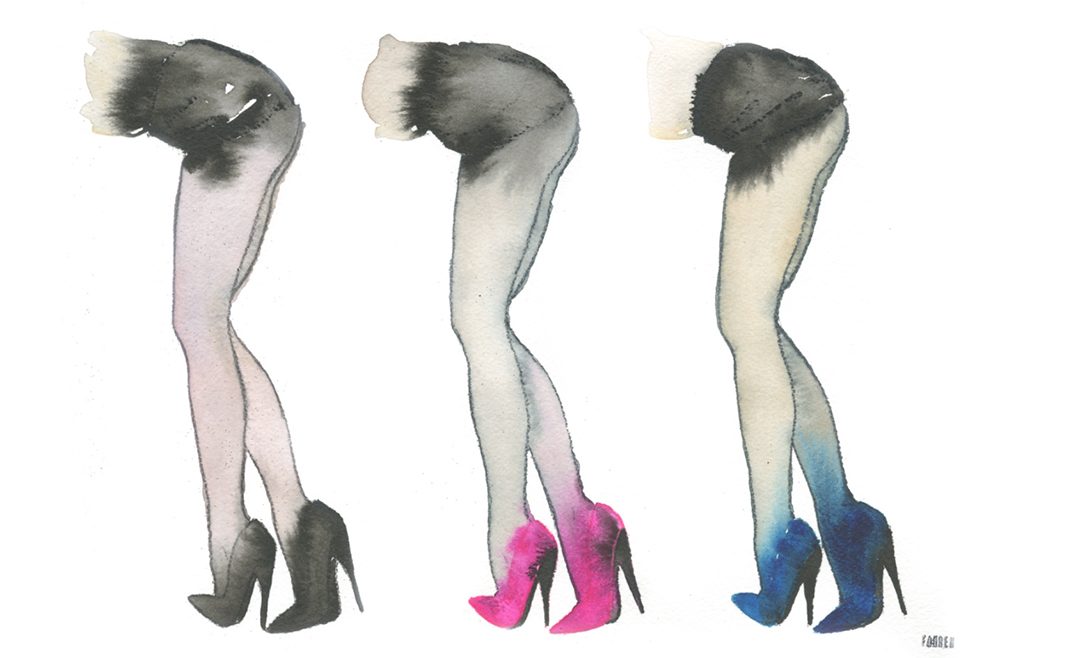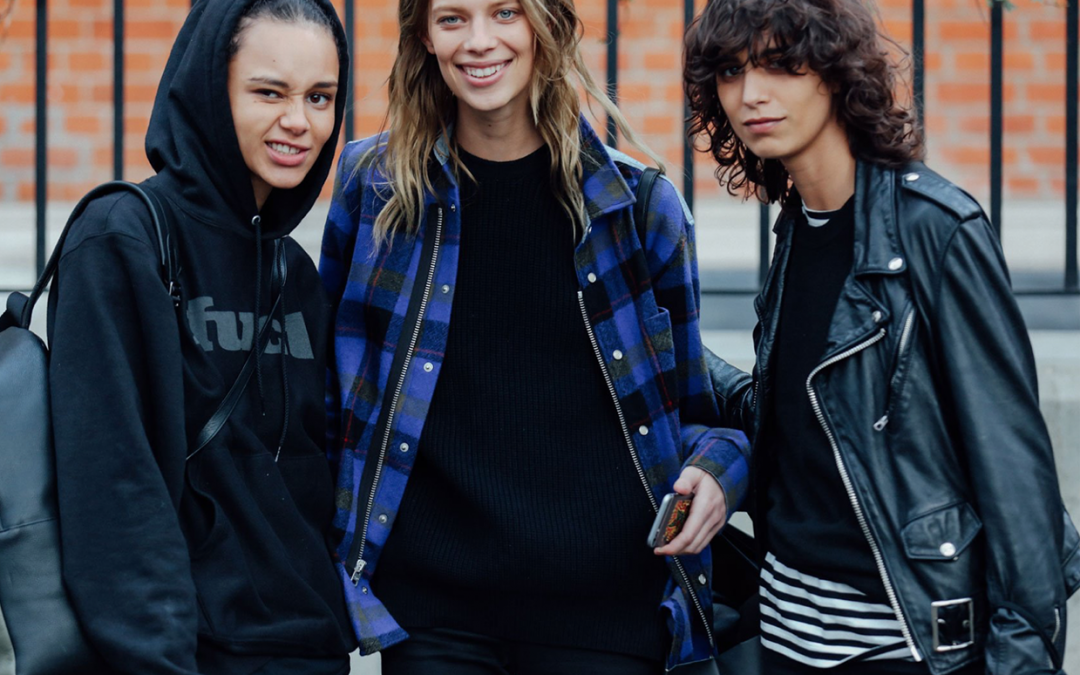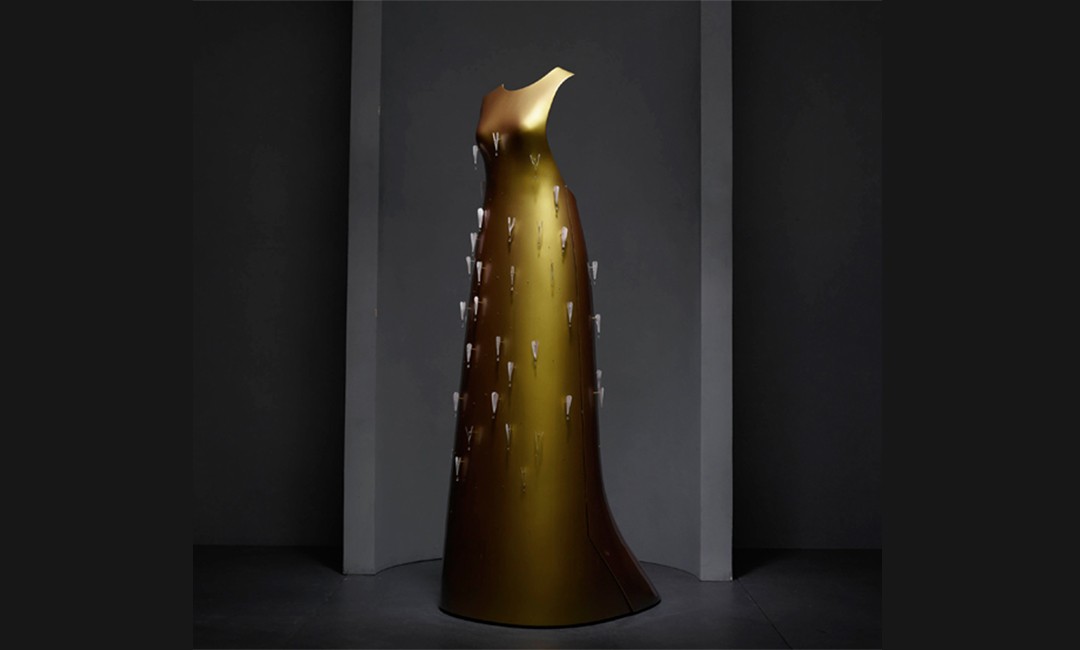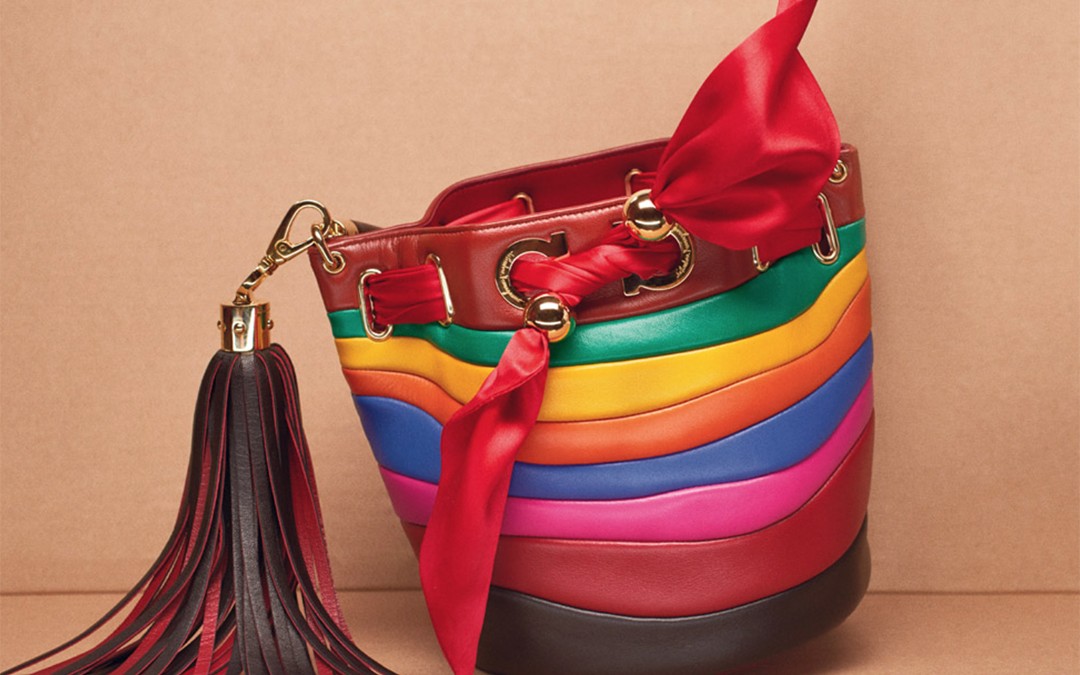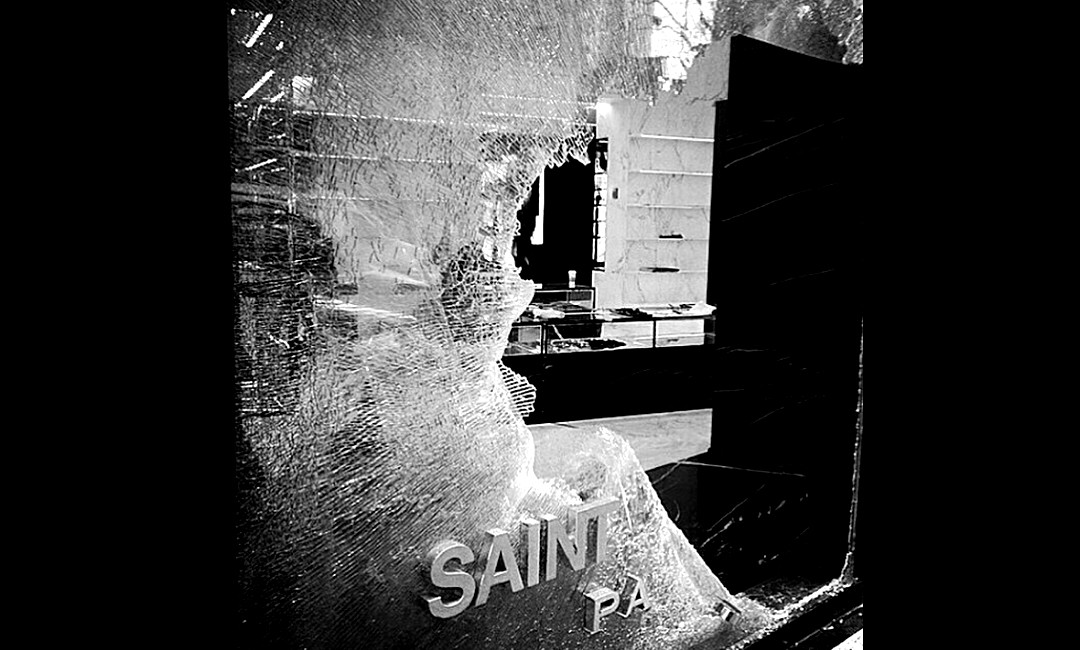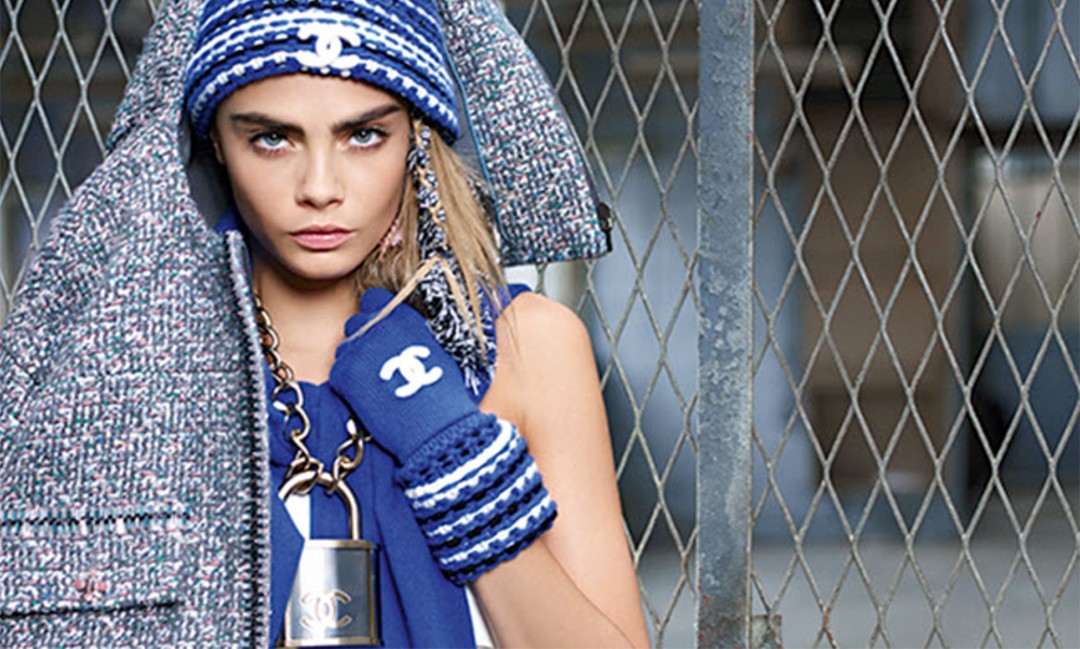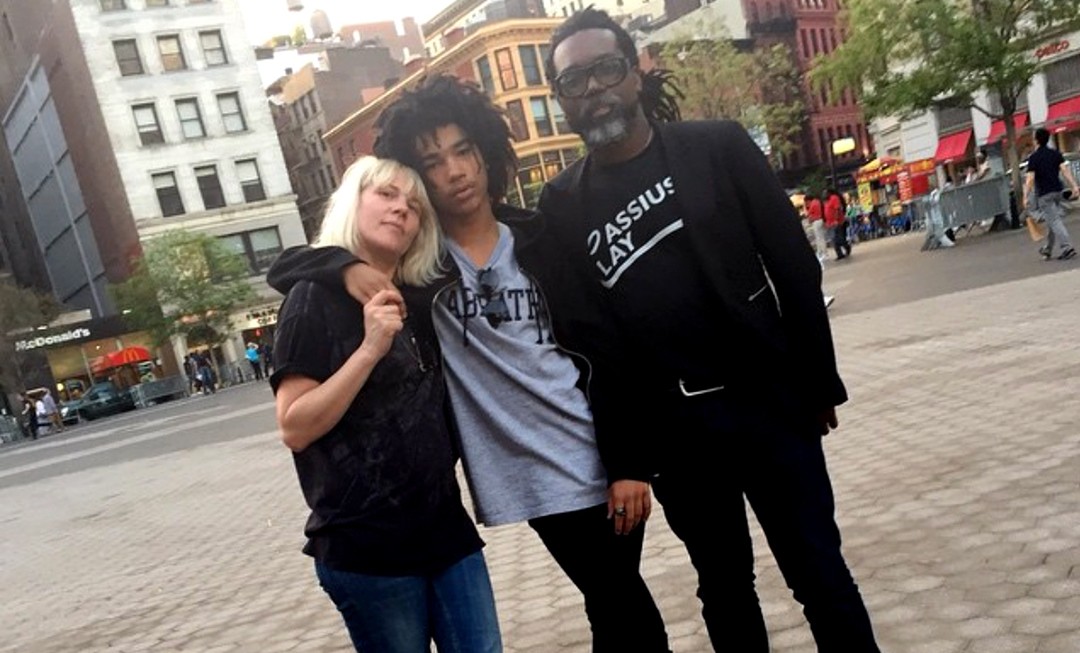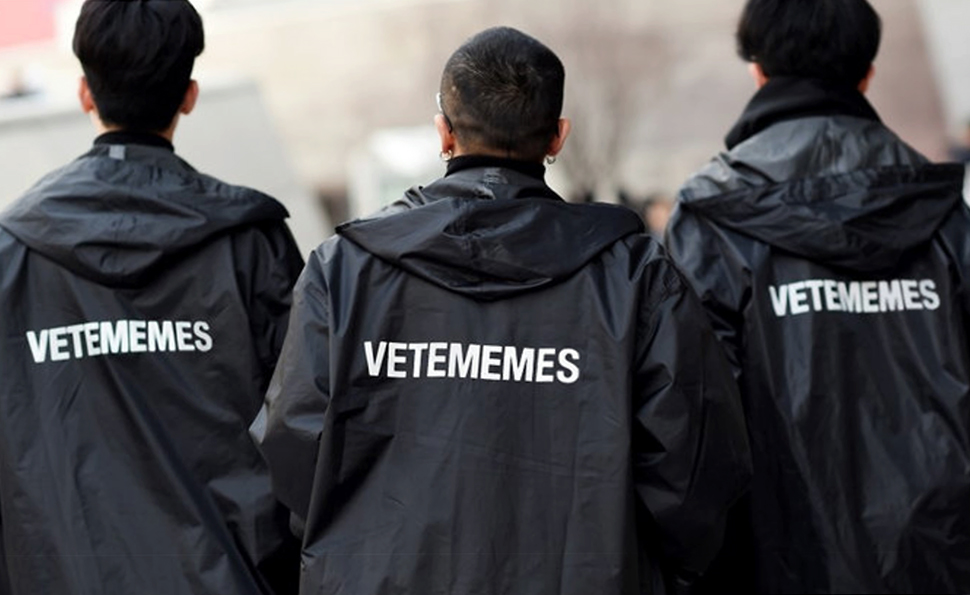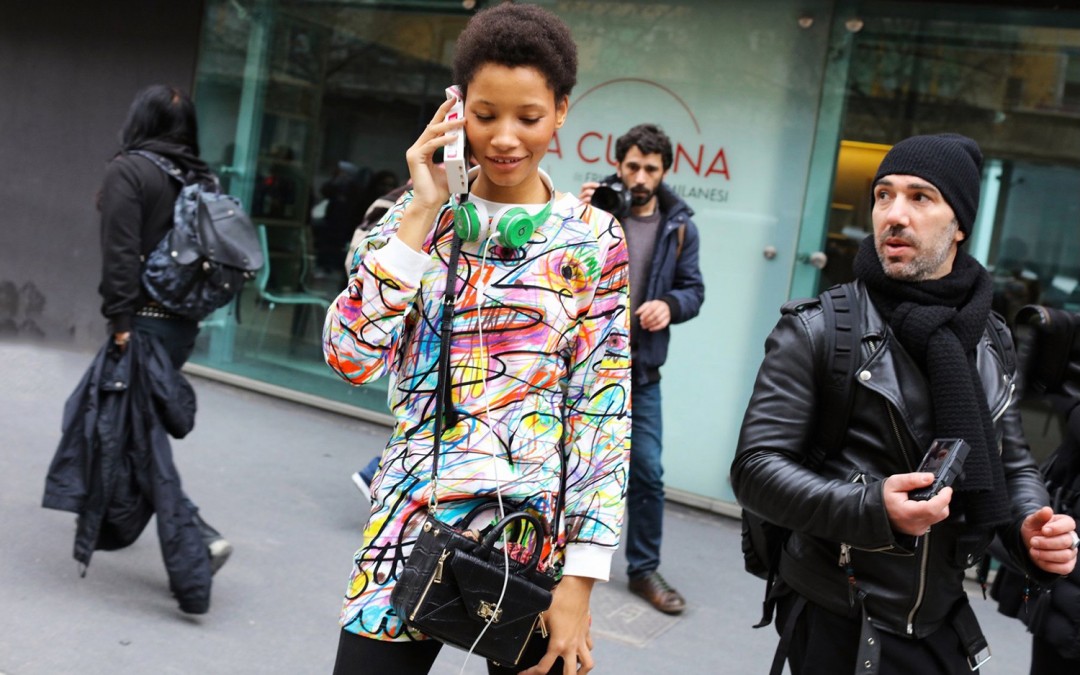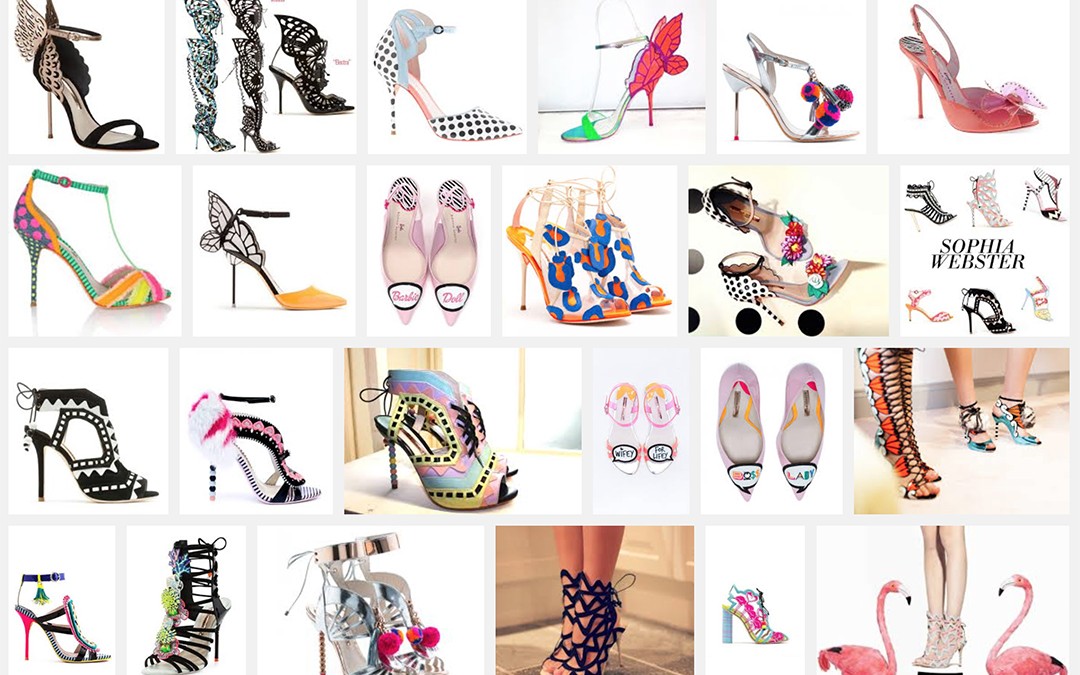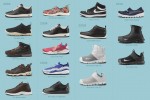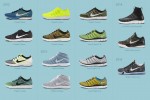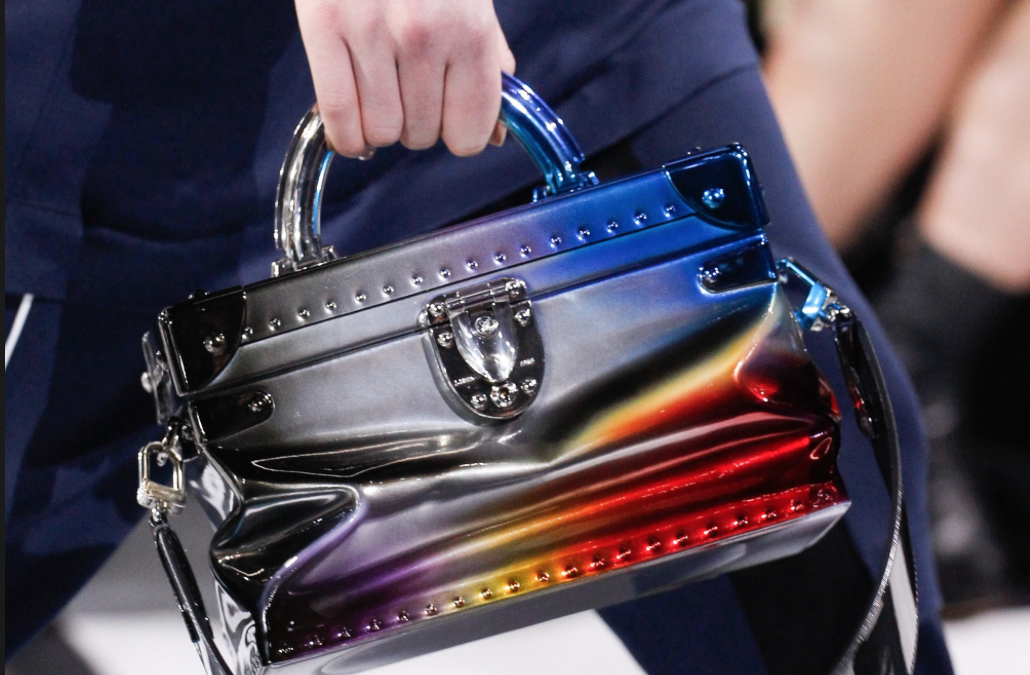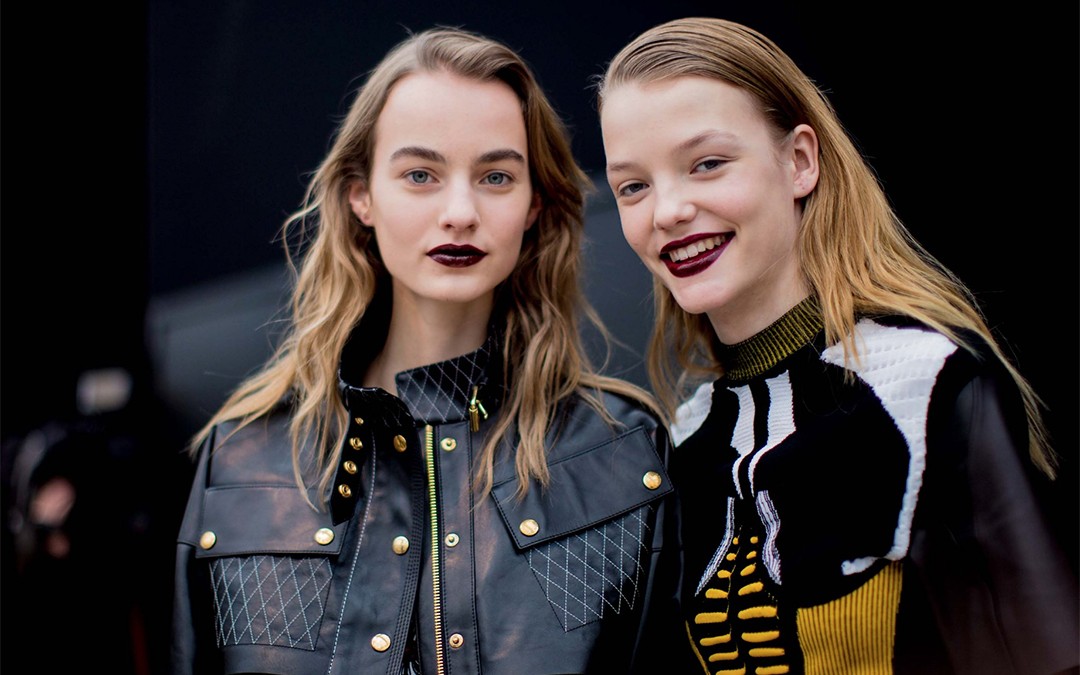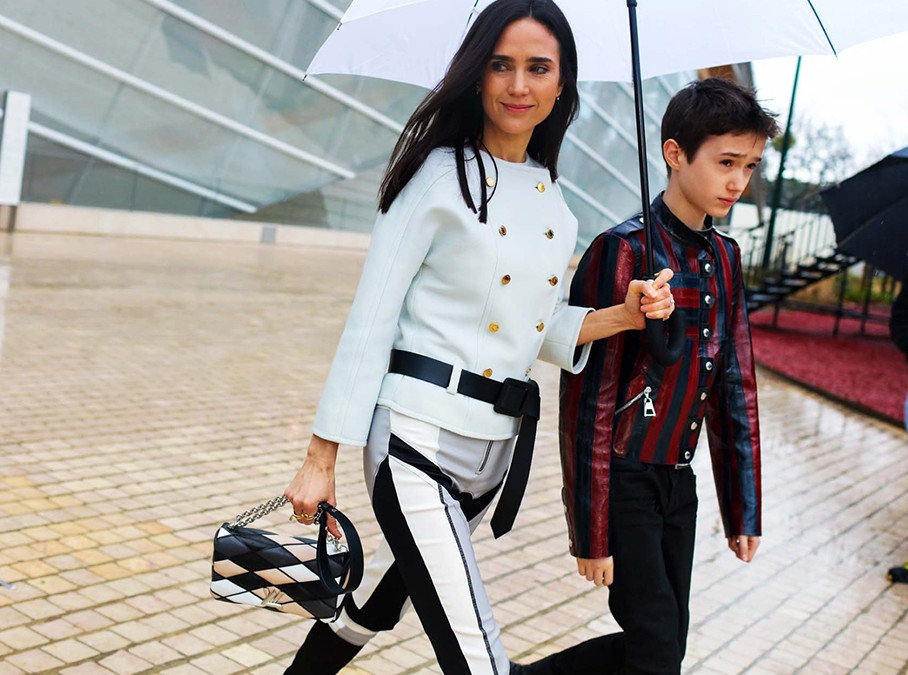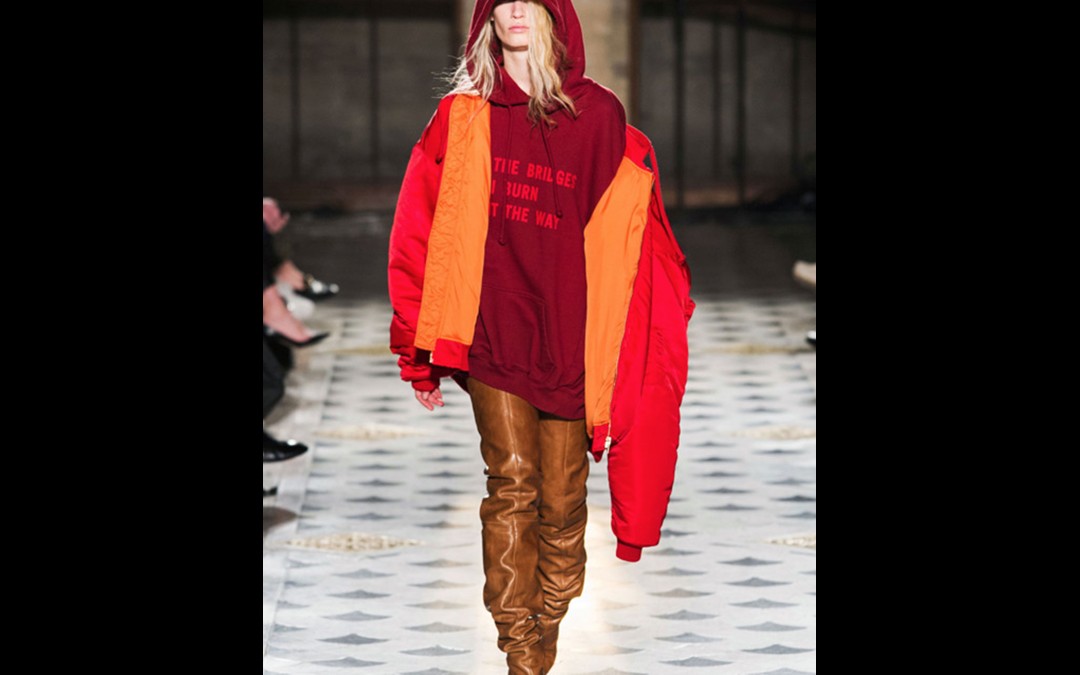In the fashion and luxury industries, selling a lifestyle and tapping into the aspirations and dreams of consumers can be as significant a motivation to purchase as product innovation and quality. As a result, marketing has long been a fundamental cornerstone of any modern fashion or luxury business. Where once marketing focused on print media and unilateral broadcasts by a brand, today it seeks to create a dialogue between brand and consumer. In this BoF Course, public relations, influencer marketing, experiential marketing, digital marketing, content marketing and demographic specific strategies are each explained and illustrated through real-life examples from leading brands, in addition to features identifying market trends and industry developments.
PUBLIC RELATIONS IN THE DIGITAL AGE
LONDON, April 5, 2011. Though they may have been slow off the mark — and indeed much slower than many of their clients might have liked — it is quickly dawning upon the fashion industry’s most respected public relations firms that their once cushy domain is being rapidly disrupted by digital media.
Simply put, no longer is it enough for PR firms to court editors of monthly magazines for editorial coverage over long boozy lunches and manage guest lists for fashion shows and events. Today’s high-powered fashion publicists are coming down from their ivory towers to help clients manage the new, constantly changing paradigm of digital fashion communication, while continuing their focus on personal relationships, which, it turns out, are more important than ever before.
Today, in exclusive conversations with the industry’s leading publicists, BoF examines how new media has transformed the PR landscape and how the sector’s top agencies are adapting to life in the digital age. Reputation management in an always-on communication cycle
“We now think in terms of information streams,” said Brian Phillips, president and chief executive officer of Black Frame, the elite New York agency that works with some of the industry’s most sought after emerging brands, including Rodarte, Nicholas Kirkwood and Band of Outsiders.
“Temporal boundaries on news no longer exist because of the possibility to feed and fill websites, blogs and Twitter with information at all times. We determine with clients what comprises their stream and these decisions are happening around the clock,” explained Mr. Phillips.
Daniel Marks, the highly-respected director of London-based The Communications Store (TCS) — which counts Net-a-Porter and Christopher Kane on its client roster — agreed. “The resource that the digital revolution created is extraordinary — allowing anyone to find information about a brand, a magazine or a personality,” he said. “Part of our job is to ensure that that information is correct.”
The importance of rapid response reputation management cannot be overstated. In the digital world, unsubstantiated rumours can run wild based on little more than a casual conversation, captured in an out-of-context tweet, ultimately reaching hundreds of thousands of people and feeding further speculation on quick-fire fashion news websites.
The most recent example of this came with speculation about potential successors to John Galliano as creative director of Dior, but Galliano is not alone. In recent seasons, everyone from Alber Elbaz to Karl Lagerfeld to Stefano Pilati has been dogged by rumours which have been turbo-charged by social media.
More publicists are intervening directly in the social conversation to nip false information in the bud. Indeed, it was a tweet from the official YSL account which finally put to rest the persistent rumours of Pilati’s impending dismissal, saying simply “Pilati busy working on the next collection. All the rumors unfounded – he is here to stay.”
Then there are those rumours that are true, but get leaked early. Mr. Marks of TCS recalls one such recent situation. “We were waiting until after fashion week to announce a new collaboration between J Brand and Christopher Kane,” he explained. “A very high profile editor-in-chief, who was privy to the information, gave an interview to an online video crew and mentioned the new collaboration. The editor was unaware that the information was embargoed as the designer had not told her.”
Sensing an opportunity out of the editor’s unintended scoop spreading online, TCS issued a release announcing the new collaboration slightly ahead of time. “Online means you have to be nimble as a PR,” asserted Mr. Marks. “Reaction times have to be quicker and more efficient.”
Relationships — not numbers — count most in blogger engagement.
Of all the social media phenomena surrounding the fashion industry, possibly none has received more attention than the rise of the fashion blogger. Fashion publicists are the first to acknowledge the growing importance of this new breed of fashion influencer, but emphasise that relationships drive decisions about which bloggers to work with.
“We can see very directly who helps sell products or who has the greatest influence and number of followers,” said Mr Marks. “Some of the selection process is based on numbers, but much of it is based on good personal relationships.”
Relationship-building with bloggers reached new levels during the New York Fashion Week just past, when PR Consulting founder Pierre Rougier encouraged his clients, Proenza Schouler designers Jack McCollough and Lazaro Hernandez, to speak at the Independent Fashion Bloggers (IFB) Conference, just days before they debuted their critically acclaimed Autumn/Winter 2011 collection.
This kind of active blogger engagement strategy may have appeared as an abrupt volte-face for Mr. Rougier, who like many other fashion publicists had been reluctant to engage with the blogosphere at first. But at the IFB Conference, evidence of his change of heart (and mind) couldn’t have been more clear. “Our goal is to maximise our clients’ place on the web and to enhance visibility for all that they do, in addition to promoting and driving users to all their social media channels,” he said.
But agencies are still exercising caution when it comes to blogger engagement. “Sites such as Huffington Post, The Daily Beast, and The Business of Fashion are now institutional publishing organisations that follow journalistic codes. We tend not to work with self-published blogs, unless we have long term relationships built with the individuals behind them,” said Mr. Phillips of Black Frame.
Monitoring, amplifying and measuring social buzz.
But as KCD senior vice president of public relations Rachna Shah points out, social media engagement transcends the fashion blogosphere.
“The digital revolution has given a voice and a relevance to a much larger, more diverse group,” she said. “The ascent of bloggers has certainly been a buzz topic for the media, but it’s really the interactive role of the public and the consumers that have produced the most significant shift.”
Ms. Shah’s point is a critical one. With the rise of social media and user-generated content, the balance of power between fashion companies and end consumers, in terms of who shapes overall brand perception, has shifted dramatically. In fact, communal consumer conversations are already drowning out official brand communications.
Mesh Chhibber, managing partner of Relative MO, agreed. “The official agenda is no longer set by newspapers of record,” he said. “We can now see how Twitter can drive the communications agenda. It changes everything.”
Indeed, when they find the right opportunities, many PRs — including Relative MO, PR Consulting, Starworks, and more recently, KCD — are using their own Twitter accounts to amplify positive conversations about their clients. “We have a Twitter account that acts synergistically with what our clients are doing online already, and further enhances the scope of reach for everything we work on,” explained Mr. Rougier. But Mr. Marks of TCS — which does not have an agency-level Twitter account — sees things somewhat differently. “We are here to amplify our clients’ voices — not our own,” he said.
To track, measure and understand consumer sentiment and opinions, PR firms are also beginning to use social media monitoring tools like Topsy.com and Radian 6, as well as analytics tools like Google Analytics, Quantcast and Klout to measure online influence.
“We definitely take advantage of online tools to report on web analytics and monitor and quantify social buzz,” said Ms Shah. “As we move forward, Twitter and other social mentions will become widely accepted as legitimate PR value, so we’ll continue to research tools that give us more accurate figures in terms of social reach as these only strengthen and diversify our impact as publicists.”
Streamlining traditional PR processes with digital tools.
But Digital PR is not restricted to communications alone. For several seasons now, fashion PRs have been integrating digital tools into their operational processes, particularly those that involve complex logistics such as event planning, inventory management, and sample tracking. More recently, they have been ditching their trademark clipboards and brandishing snazzy new iPad guest lists instead.
Much of this new technology is powered by Fashion GPS, an emerging leader in developing technology tools designed for the fashion PR industry. “I wanted to digitise and streamline the entire process including reporting, which was the most apparent requirement at the time,” explained Fashion GPS founder and chief executive Eddie Mullon. “Initially, I developed a very primitive version of Fashion GPS just for KCD’s sample tracking, but the underlying spirit and incentives carried over to all areas of the fashion process.”
Today, Fashion GPS’ tools and technologies have been implemented by more than 80 clients, including KCD, Starworks Group, Arcadia Group and Louis Vuitton, and more than 1 million samples have been trafficked worldwide.
But while new tools and technologies are an important part of PR in the digital era, these can never replace real insider knowledge. “Nothing beats recognising an editor in person to show them to their seat at a show and knowing their deadlines, filing days, what inspires them,” cautioned Daniel Marks. “No amount of technology can teach a PR that.”
Building digital expertise from inside — and out.
Most of the PR agencies admitted that they are still learning how to exploit the potential of social media in favour of their clients, and many are seeking external advice or hiring experts from non-fashion agencies to bolster their digital media expertise. KCD and Starworks are going one step further, building out entire divisions focused on digital PR.
“Previously KCD had two main divisions, PR and Production (handling fashion show and events), but KCD Digital will marry digital elements of both divisions and apply our fashion expertise to not only clients within the fashion industry but also to digital or technology brands seeking fashion industry access,” explained Ms. Shah, whose team was behind Nicola Formichetti’s first Mugler fashion show, the social media event of the season.
Starworks Group founder and chief executive James Grant has also prioritised the digital agenda, hiring individuals across all disciplines of digital marketing to be led by Rob Holzer, the newly-named global director of digital and integrated services for Starworks, serving clients including Loewe, Kate Spade and SHOWstudio.
“His keen business perspective and creative expertise in this area has already invigorated an impressive roster of fashion, beauty and lifestyle brands and will serve as a vital asset to the agency as we look to grow and expand our portfolio,” said Mr. Grant in a press release. Prior to setting its sights on digital PR, Starworks had already been moving from its core celebrity placement and casting business into fashion PR.
What’s clear is that Mr. Grant and his counterparts see digital PR as a huge opportunity for their clients, and a significant opportunity for their own agency growth and survival in the digital age.
“If brands can fully understand how to leverage their messaging and assets across digital platforms and engage with an active audience,” he said, “they can utilise the most powerful communications and sales tool that has ever existed in fashion.”
A Wake-Up Call for YSL’s PR Team

PARIS, October 2, 2012. A few weeks ago, Yves Saint Laurent’s PR team wrote to BoF, asking that we edit a tweet.
We had shared one of the striking new Saint Laurent campaign images with our followers, referring to the campaign as ‘Saint Laurent Paris.’ Brands often write to thank us for sharing their advertising campaigns with our community, but this was the first time that a brand had written asking us to rewrite a tweet. What was the problem?
“Paris is only used in the logo and not for the RTW name, that being just ‘Saint Laurent,’” the PR wrote, referring to a number of changes to brand communications implemented by Hedi Slimane when he took the creative reins at the house. As many in the PR and communications world know, however, tweets are not editable. They are also usually consumed within the first hours, if not minutes, of having been published and are soon buried under the hundreds of others that come in their wake. But not wanting to get into a debate, we simply deleted the tweet and edited a corresponding Tumblr post displaying the campaign image in question.
moreThen, last week, Saint Laurent’s press office sent out a mass email instructing media on the nomenclature we should use when referring to the brand. “The House is referred to as ‘Yves Saint Laurent.’ The ready-to-wear collection by Hedi Slimane is correctly referred to as ‘Saint Laurent’. (‘Saint Laurent Paris’ is used in the logo but not when spoken/written about the collection). Collection credits, should you photograph any items, is [sic] correctly written ‘Saint Laurent by Hedi Slimane.’”
Another mass email soon followed, saying that the previous email was “not for official use or for lifting quotes.”
It was the latest in a series of bizarre communications from a PR team whose attempts to control communication about YSL — whether coming directly from the brand itself or independent media outlets — seems obsessive. In today’s media reality, where words and images can be shared and commented on by millions of end users on social platforms like Facebook and Twitter, seeking this kind of control is not only doomed to failure, but it is also misguided.
When YSL introduced a new logo for the house, designed by Mr Slimane, on the brand’s Facebook page earlier this summer, minus any explanatory context, they had apparently not considered how their fanbase might react. Instead of adulation and adoration, thousands of YSL’s Facebook fans led a sizable backlash, partially because there was misunderstanding around how the new branding would actually be used.
A few weeks earlier, we thought it would be constructive to set the record straight. So, in an extensive feature on YSL’s new ‘retrobranding,’ BoF took care to explain the details and thinking behind the moves, collecting background information from YSL in order to understand their rationale and speaking with branding experts to gauge their reaction. The piece was widely picked up by other media and credited with helping to clarify YSL’s new branding strategy. But still, shortly after publication, we received yet another email from the company, this time from YSL’s New York press office, asking us to revise our piece without specifying what they thought was incorrect. A follow up email from our team asking for clarification was met with silence.
You see, BoF has always aimed to provide a factual, balanced and analytical perspective and when we make mistakes, we strive to correct them. Indeed, we take this very seriously. So, I must confess my surprise when I was informed by the House of Saint Laurent that I would not be invited to Hedi Slimane’s debut show for the brand because they were unhappy with the “tone of voice” that we have used when writing about YSL. Upon further investigation, it seems they took issue with the content of some of our pieces.
Specifically, they did not agree with our columnist Colin McDowell’s conclusion that while Slimane’s work at Dior Homme was massively influential and built a huge cult following, “it didn’t always translate into convincing sales.” When we explained our thinking, namely that no designer can claim that every single collection is a commercial success, and politely declined to change the article, we were informed via email: “Don’t correct, fare [sic] enough, we won’t collaborate on any kind of project in the future.”
More recently, the brand took issue with a piece we published, mentioning that some in the industry (including highly regarded New York Times critic Cathy Horyn) credit Raf Simons with pioneering the skinny silhouette in menswear, “though it was undoubtedly Slimane’s reign at Dior Homme that made it a commercial success, bringing it into the fashion mainstream.”
In all my years editing BoF, I have never encountered this kind of ultimatum from a fashion brand threatening non-cooperation. Indeed, every single time BoF has written about YSL (or Saint Laurent, or Saint Laurent Paris) we have received some kind of request to change the article to comply with what seem like the whims of the brand’s PR team, who appear to think that the media exists solely to serve as their mouthpiece.
Perhaps I should have been honoured that — along with Ms. Horyn, a writer who always calls it like she sees it and whom I greatly respect, even if I do not always agree with her — I was not invited to this season’s YSL show. But when a friend offered me a spare standing ticket to attend at the last minute, I couldn’t resist the opportunity to see Hedi Slimane’s debut for myself and I decided to go.
Despite all of the hype and anticipation, it was clear from the first few looks that the collection wasn’t going to change the future of women’s fashion, as Slimane had done for menswear during his tenure at Dior Homme. Everything I saw was true to the codes of the house and very 1970’s YSL — undoubtedly desirable for those in the market for a French rocker chick vibe. But perhaps, the somewhat muted applause and hushed voices after the show were the most telling.
I’m still not sure if attending the show was the right decision. Part of me thinks I should have just stayed away, but as my peer Lisa Armstrong wrote in her review in the Telegraph, “Judging by [Slimane’s] apparent fear of any kind of objective criticism, however, I fear I won’t be allowed back.”
Ultimately, this kind of behaviour is not only arrogant, it also reveals a fundamental misunderstanding of how winning brands are built in today’s world. Successful brands aren’t defined by a set of rules conceived in the control tower of a company’s headquarters and broadcast to the world. They are ideas that live in conversation with the world. They can’t be dictated. They must be nurtured.
It’s a serious wake-up call for a PR team that is clearly living in the pre-digital age.
INFLUENCER MARKETING
For Emerging Designers, Celebrity Sells
As celebrity dressing becomes a global media channel in its own right, BoF reports on how emerging designers are growing their brands on the backs of the biggest stars.
LONDON, United Kingdom — JANUARY 26, 201 Banks of blinding flashbulbs flank a crimson carpet. Incessant, insistent shouts beg for one more mega-watt smile, one more flick of a train. Square-jawed men in funeral black are sombre foils to the brightly coloured gowns of their escorts, a nation’s wealth of diamonds strewn upon their arms and necks. It is a scene with which we are all familiar; a scene of our times and a scene that billions around the world buy into.
The red carpet has become a mass entertainment format of its own, broadcast to millions by programs such as “Live From The Red Carpet,” a pre-show to the major film and television award shows that airs on E! Entertainment Television (an American cable and satellite channel, which reaches approximately 96 million American households and 600 million international homes) and offers a rundown of every dress, shoe and jewel, all captured in 360 degrees by “Glam Cam,” a purpose built plinth equipped with tens of cameras, giving each shining piece of appliqué and each fluttering sheaf of chiffon its time in the spotlight.
Indeed, given this kind of exposure, it’s no surprise that fashion brands have learned to tap the power of the red carpet as perhaps the most powerful weapon in their arsenal. The fact is, celebrity sells, perhaps even more than sex.
“Designers [have] learned that getting their gown on the right body [is] a force second to none,” Tamara Mellon, co-founder and former chief of Jimmy Choo, wrote in her autobiography In My Shoes. “A magazine feature [can] reach hundreds of thousands of potential customers for a fashion brand,” Mellon continued. “The way to reach a billion? Dress the actresses competing for attention at a highly televised event.”
Major luxury houses from Gucci to Dior have long tapped the power of celebrity dressing to build their brands and boost sales (if not of the dresses themselves, then of more attainable product lines like accessories and beauty). But today’s red carpets are no longer the exclusive territory of fashion’s biggest players. In fact, as its power and reach continue to grow, celebrity dressing has fast become a pathway by which emerging labels are establishing themselves, building global brand awareness and driving sales.
“The starting point for me was when Zoe Saldana wore a dress to the Star Trek premiere in Germany,” designer Prabal Gurung, who founded his self-funded label four years ago, told BoF. “Then it was Demi Moore, she announced on Twitter, ‘Oh I am wearing this new designer to look out for.’ All of a sudden, I went from 18 followers to 300 or 500 followers on Twitter and then it took off. Last year, four years in to our business Google did this top-searched brands of 2013 list and ours was seventh! It has had a tremendous, tremendous impact in every way.”
That is every way, including sales. “Diane Kruger wore this dress and immediately it was on Moda Operandi on pre-order,” added Gurung. “These are expensive dresses and there were many more orders. Same with Sandra [Bullock]’s gown,” which the Oscar-winning actress wore to the 2014 Golden Globe Awards. “You see immediate impact.”
“What [celebrity dressing] also does is make the meetings that you always wanted to have — whether it is a retailer or any kind of business deal — [happen]. They’re open to it because they know who you are. It opens doors,” continued Gurung.
“When I meet someone that I gravitate towards and am inspired by, I work with them. It’s organic. I think there is a lot of exposure for both the designer and the celebrity when it is a perfect match,” added New York designer Jason Wu, who founded his eponymous label in 2006 and has dressed actresses Emma Stone, Kerry Washington and others.
Top-tier celebrity stylists like Petra Flannery, Elizabeth Saltzman, Leith Clark and Mel Ottenberg are the gatekeepers who can break and build brands, simply by guiding their clients towards a certain garment. But catching a stylist’s eye is no simple task.
Alana Varel, director and co-founder of Starworks Group, a global communications agency with offices in London, New York and Los Angeles, told BoF: “It’s important to have designers come to LA and spend face time with stylists and talent to really lay the ground work and build a personal relationship, for instance through our work with the British Fashion Council and their seasonal London Showrooms.”
“The red carpet and awards season is such a global platform and incredible opportunity for our emerging designers to build their brands and get their name out there,” said Caroline Rush, chief executive of the British Fashion Council on the importance of the organisation’s London Showrooms and London Style Suites, an initiative launched last November, specifically conceived to promote British designers in Los Angeles, which has attracted the likes of David Koma, Matthew Williamson, Osman and others. “LA is the home of the red carpet and activity in this market is aimed at securing designers’ reputations as the go-to brands for the increasing number of events during the awards season,” read a BFC statement issued at the time of launch.
But the relationship between celebrity stylists and designers is symbiotic. While emerging brands seek exposure, stylists aim to uncover and work with fresh design talent to meet the constant demand for the kind of new looks which can help their clients to build their personal brands on what is a highly competitive stage.
“There are a lot of people out there that get a lot of attention and that are actively seeking a lot [of attention]. To me, it is always looking forward to find something new and cool that other people haven’t worn yet,” said Mel Ottenberg, fashion director of 032c and Rihanna’s stylist. “For every video, every photo shoot, album cover or red carpet [event], I take the same attitude. That is how we keep it moving. I love working with someone like a Givenchy, or Balmain, or an Alaïa for those big moments, but it’s great and really fun to work with [emerging designers] Adam Selman or KTZ for those moments too and do something no one else has done.”
Of course, stage-managed appearances, and images of celebrities actually doing their day-jobs, are now only one aspect of celebrity dressing. Indeed, for the world’s most photographed individuals, the omnipresent paparazzi have turned every moment of their lives — from exiting a hotel to going to Starbucks — into a photo call.
“We were dealing with bloggers and they were really hard work,” said Christopher Bookless, the designer of emerging streetwear brand Less Clothing. “We would send them a top and they wouldn’t even blog it, so we thought, ‘Why are we wasting our time here? Get one A-lister wearing it and it will snowball.” Five samples of his collection were sent out, one directly to a hotel where Beyoncé was staying, “and then next thing you know, New Year’s Day, [paparazzi shots of Beyoncé wearing a Less crop top] came through. Then, three days later Cara Delevingne was wearing it. I have had features in magazines, but with [Knowles and Delevingne] wearing the clothes, it went crazy for a week and the sales boosted by tenfold online.”
But as an emerging brand, Less Clothing is not in a position to send out gratis products to every celebrity and recipients are chosen for two key qualities. “It is about how they fit the brand in terms of what they wear, but obviously if they have got a big [social media] following as well — those are the main factors.” And indeed, thanks to the explosion of celebrity photo-sharing on platforms like Instagram, emerging brands may not even need to rely on the paparazzi to photograph a celebrity wearing their product; the celebrity might just do it for them.
“It is super aggressive, you have no idea how many Christmas presents came through my office. It was wild. I would say that my office is like a thousand square feet and it felt like my entire office was filled to the brim with presents for Rihanna,” noted Ottenberg. “Everyone wants to get in on the social media party. Brands [of all sizes] have realised how huge that is now. People really, really, really want to get on Instagram and all of that, because really people see it.”
Rihanna, or “BadGirlRiRi,” as she is known on Instagram, has attracted over 11 million followers on the platform. Cara Delevingne has about 4 million Instagram followers, while Beyoncé has 9 million, numbers that eclipse the circulation figures of most major fashion magazines.
“With the rise of online journalism and social media, brands now have a window to immediate global exposure,” said Julietta Dexter, co-founder and director of The Communications Store, a public relations agency based in London. “The dressing of a major public figure has the power of introducing a brand not only to new consumers, but new markets, as well. Strategic brand alignment for an emerging designer or label is pivotal in ensuring the correct level of exposure to a target consumer.”
However, for emerging brands, earning top-tier editorial remains vital. “Both [editorial placement and celebrity dressing] play crucial roles in terms of brand positioning,” continued Dexter. “While celebrity dressing allows mass exposure to new audiences and territories, editorial placement will always be key for luxury brands in reaching their target consumer.”
Dressing celebrities has its advantages, however. “Celebrity placement has such longevity in the market place,” Varel explained. “Images can be used on an ongoing basis, months or even years after the initial placement with far reaching implications past editorial, onwards to the sales teams, retail and, of course, the consumer.” In addition to longevity, “[celebrity dressing] represents a strong return through significantly lower investment.”
Ottenberg added: “I think that today [emerging designers seek to dress a celebrity] a lot more aggressively than they want to be in a magazine. The immediate social media reality of somebody wearing their clothes, at the moment, has a really big impact… Although magazines do a huge amount for emerging designers, they really do, there are no constraints on who a celebrity wears. A celebrity doesn’t have an obligation to his or her advertisers.”
“My PR and I were talking about getting into i-D,” said Bookless. “She was saying that it’s hard to get into those magazines now, because you have to wait for the stylists to get in touch, once they have been commissioned for the shoot. Really, there is a lot of time wasted doing that. You may as well try and meet to hand over the clothes – or don’t even bother with the magazines – just get your stuff on a celebrity.”
How Celebrity Sells in China
Luxury brands are casting a wide net to find Chinese celebrity ambassadors, but some must now realise that a great catch is not always the right match.

SHANGHAI, January 27, 2015 When Chanel tapped songbird Coco Lee to be its Asian brand ambassador fifteen years ago, it brought turbulence to the steady old guard of Hong Kong’s socialites and high-flyers. Some of these lifelong loyal matrons were so perturbed by the association with a local pop star that they revolted with their pocketbooks, eschewing Chanel at the shops for a time. The brand’s PR team immediately swooped in to placate them, but this episode remains one of the first ‘crises’ caused by the collaboration of a luxury brand and a Chinese celebrity.
A lot has changed since 2001. Today, being a luxury brand spokesperson is no longer the preserve of a few global Hollywood superstars. The world is more diverse and the centre of China’s luxury market has moved from Hong Kong to the mainland and, as it spread out to the country’s aspirational classes, ceased to be the dominion of the privileged few. In this now vast, complex and often self-contained Chinese market, using the visual language of local stars to convey a marketing message has become ever more important. But in spite of all this, the art of matchmaking luxury brands to local stars has not got any easier.
The reality is that China’s top celebrity resources are pretty scarce. Many young talents have become popular through soap operas and reality shows, therefore lacking the sophistication and individuality that would make a consumer base view them as the embodiment of elegance, glamour or original personal style. The cumulative effect of this talent scarcity is that a battle has been raging over the past few years between brands wanting to sign the same tiny cadre of top Chinese celebrities.
Tim Lim, the fashion director of Modern Media Group, which publishes Modern Weekly magazine, explains it best: “In China, the cooperation between stars and luxury brands is not really a search for the perfect combination, but a search for a reasonable solution.” One problem is that few celebrities in China will take on a collaboration because of personal ties with the designer, as they often do in the West. Another is that few luxury brands understand or consider all of the relevant factors before partnering with a Chinese celebrity.
A battle has been raging over the past few years between brands wanting to sign the same tiny cadre of top Chinese celebrities.
But the blame is not only with the luxury brands and the celebrities, according to Jude Robert, one of the founders of the Chinese luxury consulting and public relations firm RTG. He believes that another issue is that there is a less developed celebrity management industry in China – in particular, a lack of professional celebrity publicists.
“Chinese celebrities are not managed in a thoughtful way. Can you imagine Hollywood not having celebrity publicists? A seasoned celebrity publicist determines the kind of image the celebrity should have, what kind of activities to attend, what kind of collaboration offers to accept and what kind of publicity strategy should be developed,” he says.
“In China, this role is often assumed by brokerage firms, and their attention is often focused on short-term financial return, not the long-term brand value of the celebrity. This market fundamentally lacks the sound rules and setup [needed]. This has to change.”
Playing the Long Game at Chanel
In what is essentially a delicate matchmaking game, collaboration between luxury brands and celebrities in China should be part of a precise, comprehensive, long-term plan, and not just a sparkle that can be quickly extinguished. Despite — or perhaps because of — the reaction to its first foray with Coco Lee 15 years ago, Chanel’s strategy of using Chinese celebrities is now considered to be one of the most successful. And much of that success can be attributed to a quality that is rare in the Chinese market — patience.
Never hasty to buy into any kind of partnership, Chanel carefully and steadily cultivates its ambassadors, year after year. Before signing Zhou Xun as the brand’s ambassador for China in 2011, Chanel had been collaborating with the actress and singer for five years. Over this extended period of time, the brand was able to determine that Zhou Xun’s qualities and image were indeed consistent with Chanel’s. And in order to make sure this would continue, as soon as the deal was sealed, Chanel started to effectively influence all aspects of her professional life, from public appearances to having a hand in choosing her outfits, make-up and hair styles.
Chanel didn’t try to make Zhou Xun into a walking billboard for its products. Instead, it chose the singular Chanel style that fit her best. At the same time, Chanel understood how to take advantage of every hot topic that surrounded her, like when, last May, Zhou Xun announced her new love interest — and a wedding date two months later. In this incredibly short period of time, Chanel’s PR team in China came up with a plan to take her to Paris to have a wedding dress custom made, and publish the photos on the Vogue China website. The result was reportedly a lift in the number of page views and page shares for the site — not to mention added retail sales for Chanel.
Backfiring at Gucci
Ambassadors and spokespersons bear the responsibility of promoting a brand’s image and values. But choosing a top-tier celebrity is not always the best way to achieve that. Sometimes it can even blow up in a brand’s face. In 2012, Gucci signed the acclaimed actress Li Bingbing as spokesperson for Asia, and named her global spokesperson a year later. But this move did not convince many people in China, as Li Bingbing’s fresh elegance was drastically different to the luxurious and sensual image of Gucci.
The ensuing video adverts and modeling collaborations did not bring acclaim to Gucci, but, on the contrary, vividly showed the disharmony between Li Bingbing and the brand. When she appeared at the Cannes Festival with the iconic Gucci smoky-eyes, make-up and dark, vampy evening gown, the verdict on Chinese social media was that “she looked like a drunken mess.”
Of course, Gucci’s popularity in the Chinese market has been declining due to factors much greater than Li Bingbing’s involvement. But, ultimately, a local spokesperson with Li Bingbing’s fame did not mitigate Gucci’s decline, as the brand had hoped it would. And what came next rubbed salt in the brand’s wounds. Despite her contract with Gucci, Li Bingbing appeared at a Dior fashion show, leading market observers and consumers to question the integrity of her relationship with Gucci — and Gucci’s influence over its spokeswoman.
A Quick Lift at Louis Vuitton
Many luxury brands are already widely known in China and able to stress their core values, culture and image by using other marketing strategies. So the question remains, why do they still need a celebrity to promote their ‘spirit’? Sometimes, a celebrity is the most effective way for a brand to adjust to or show flexibility to a local market like China, at a particular time in its development. Engaging a celebrity to promote a particular category or item in a brand’s collection is one example of how this can work.
In 2012, Fan Bingbing became the spokesperson for Louis Vuitton’s Alma handbag line. The combination of one celebrity with one key product had an instant effect. The sales of the Alma skyrocketed, with Chinese consumers calling it “Bingbing’s bag”. Having a celebrity association here worked especially well because the Alma bag is a low-key style with an understated logo.
Janie Zhuang, Louis Vuitton’s former public relations manager for China, witnessed the entire process. “At the time, we were sure that the Louis Vuitton monogram was widely recognized in China, but we’d never really had a famous handbag model. Fan Bingbing popularized the Alma bag as her favorite choice,” she says.
Since this marketing milestone, more and more brands began to recognize that promoting their brand image and boosting sales of a key product in China cannot always be achieved by the same campaign. Rather, that these aims often need to be viewed as parallel: complementary but different strategies. Another realization was that choosing who to employ as a celebrity ambassador — and when to employ them — is often a case of weighing up the long-term and short-term priorities of the brand in that particular market.
The overnight effect created by a celebrity may help a luxury brand give birth to a single hot product, but it does not always help with the cultivation of awareness or brand loyalty. On the other hand, in a market as fervent, chaotic and still as unpredictable as China, a brand’s judgment and adaptability are tested everywhere — including the realm of celebrity ambassadors. Getting it right means not only striking a balance, but knowing when to move the needle in a different direction.
For Fine Jewellers, the Red Carpet Means Business
Why awards season is more important than ever to gem purveyors.
LOS ANGELES, February 12, 2015 On February 22, Hollywood’s elite will walk the final red carpet of the season: the 87th Academy Awards, also known as the Oscars. While dozens of television crews will ask dozens of stars all sorts of banal questions, most interviews will begin with, “What are you wearing?”
The sartorial stakes will be highest for those nominated, particularly the women, whose dresses will be critiqued across the internet and print publications for weeks to come. Last year, Best Supporting Actress winner Lupita Nyong’o cemented her place as a leading style star thanks to her sky blue Prada gown. This season, the hope is that nominees including Julianne Moore, Felicity Jones and Keira Knightley will make unique, just-daring-enough fashion choices.
To be sure, the competition to dress these women is fierce. The bigger the star, the more choices she has, and the more likely she is to change her mind at the last minute. Stylists often request that designers make custom gowns for their clients, which they don’t always end up wearing. Some brands choose to pay actresses to wear their dresses. Marion Cotillard and Jennifer Lawrence, for instance, both star in advertising campaigns for Dior, and almost exclusively wear the Raf Simons-designed label on the red carpet. But pay for play is less common than one might expect, at least when it comes to clothes.
Fine jewellers, on the other hand, are much more likely to enter into a contractual agreement with an actress. “If you look at just 10 people, six or seven of them are already taken [by fine jewelers], oftentimes with very large, lucrative contracts,” explains Alana Varel, partner at brand management and marketing agency Starworks Group. “For the three who aren’t, there’s a lot of betting and bidding going on until the day of the show.” A one-time appearance at a major event like the Oscars can earn an actress somewhere in the mid-six figures, while longer-term deals for A-listers typically start at seven figures.
A one-time appearance at a major event like the Oscars can earn an actress somewhere in the mid-six figures, while longer-term deals for A-listers typically start at seven figures.
For instance, when Charlize Theron was paid $3 million to star in an ad campaign for watchmaker Raymond Weil, she was also required to wear the watch in public. (A 2008 lawsuit brought against Theron by Weil revealed that she was also paid $200,000 to wear Chopard gems to the Academy Awards, and $50,000 to wear them to the BAFTAs.) “Today, the fee is still going to be in the mid-six figure to the low-seven figure range, with the celebrity participating in various advertising for a brand,” says Stacy Jones, president of Hollywood Branded, a consultancy.
While these sorts of deals are more prevalent now that the red carpet’s cultural significance has increased, Hollywood’s relationship with fine jewelers is as old as the entertainment industry itself, with many actresses doubling as clients. (Elizabeth Taylor’s personal gemstone collection fetched $137 million when it was auctioned off in 2011.) “We had extensive relations with key celebrities in the 1960s and 1970s,” says Piaget CEO Philippe Léopold-Metzger. “The Rat Pack, Andy Warhol, lots of very famous actresses.” Jacqueline Kennedy Onassis was also a client.
But the influence of the red carpet on a global audience has made building long term relationships with A-list actresses all that more important. For instance, Geneva-based Piaget recently signed on Jessica Chastain as its international brand ambassador. The actress, who starred in four films in 2014, with three more coming in 2015, will make appearances at brand events and wear the jewels on the red carpet, although she will not star in advertising campaigns. “It was important to me to find someone who was smart and beautiful and a story, with a long future in Hollywood,” says Léopold-Metzger. “She’s recognisable, with a very distinctive look.” The contract with Chastain is the next step in an ongoing effort “to get back to Hollywood in an intelligent manner.” Eight years ago, Piaget began sponsoring the Independent Spirit Awards and in October 2014 opened a store on Rodeo Drive. “We work with [Memoirs of a Geisha actress] Gong Li in Asia, and it was important to find someone in Hollywood that would match Piaget’s values,” he says. “That’s Jessica.”
Gemfields, the London-headquartered producer of colored gemstones, hired Mila Kunis as its global ambassador in 2013. Unlike traditional jewelery brands, Gemfields is primarily a supplier, which means Kunis wears pieces by other designers that utilise the company’s stones. At the premiere of her latest film, Jupiter Ascending, the actress wore jewellery by Miiori and Marina B featuring Gemfields’ Mozambican rubies — a particularly important category for the company, due to the scarcity of more traditional Burmese rubies. (At a Sotheby’s sale in March 2014, a 29.62-carat oval Burmese ruby and diamond ring sold for $7.3 million, the highest price ever paid for a ruby at auction.) Gemfields, which was established only in 2009 by mining industry consultant Ian Harebottle, needs to capitalize on the demand and popularity of colored gemstones.
“For us, it’s a two-tiered approach,” explains Anna Haber, Gemfields’ director of marketing. “We’re marketing our gemstones to the jewelers and brands, and then we’re working to educate the consumer on colour gemstones overall, to get them excited about [the category].” That’s where Kunis comes in. Along with starring in the brand’s advertising campaigns, the public relations team works hard to ensure that Gemfields is credited any time a photograph of her wearing a piece is featured in an online or print publication. “We chose Mila because she’s very natural, and she knows her own mind, as well as being very beautiful,” Haber says. “[Her look] also works across many different markets. We’re not just working in America — we’re in the Middle East, India — we found that she resonates with customers globally.”
Bringing on an ambassador has become more and more common among top-tier brands, but there are some who still choose to work with celebrities on a case-by-case basis. Pascal Mouawad, co-guardian of Mouawad, the 125-year-old jeweler with headquarters in Geneva and Dubai, prefers to deal directly with stylists and managers instead of brokering a deal with an actress’ talent agency. “In 2002, we hired Heidi Klum as a brand ambassador, but now we don’t like to be associated with any particular star,” he says. “Celebrity association can be great for brand awareness, but what happens if that celebrity ends up endorsing another brand that’s not a good match with your brand? For instance, Heidi had a deal with McDonalds in Germany. We are a diamond company, and next thing we knew our ambassador was also promoting McDonalds. That’s not an association we want to have.”
Mouawad even stays away from the one-night-only deals, which preserves his marketing budget but means that placements are less predictable. “We don’t like to pay,” says the exec, who cites Amy Adams’ 2013 Oscar look as one of the house’s biggest red carpet moments. “That’s why there’s no guaranteed placement. We have spectacular pieces. But right now, I couldn’t tell you who’s going to wear my pieces because it’s too early.”
But there are few fine jewelery houses willing to risk missing the Oscars red carpet. “Oftentimes the dress is specific — it’s made for that woman, for that evening — and doesn’t have as broad an appeal as an amazing pair of diamond earrings, which are more likely to appeal to a wider range of women,” says Jim Kloiber, principal at strategy firm GCK Partners, who has worked Harry Winston and De Beers Group of Companies in the past, as well as Piaget and Gemfields. “There’s definitely a bigger opportunity from a commercial standpoint.” An Oscar winner’s look will be cemented in the minds of consumers for decades. Consider the 40-carat Harry Winston diamond necklace that Gwyneth Paltrow wore while accepting the Best Actress award at the 71st Academy Awards in 1998. Not only did Paltrow’s father buy her the necklace, but the jeweller sold several more the following week.
These appearances occasionally result in actual sales, but also allow jewel\lers to sometimes convert actresses into paying clients. “There is a myth that nobody owns their own jewelery anymore. You would be surprised by how many celebrities become clients of these brands,” says Kloiber. “Most of these companies will not discuss their clients and specific sales — they’ve very much about discretion. But it really does happen. If [red carpet dressing] wasn’t so effective on so many levels, it wouldn’t be happening.”
To be sure, it’s the jewelers with the most cash to spare that tend to secure the best celebrities. Not only is there the actresses’ fee, there is also the matter of security and transportation of the gems, which can run into six figures for one evening. “You’re dealing with pieces that are so expensive that there is a lot of handling from place to place. You need the infrastructure to be able to pull it off,” says Starworks’ Varel. “To play in this game you need to be able to afford it. It’s a very expensive space. Everyone gets lucky sometimes, but it’s getting harder for smaller, or newer brands. It’s too competitive.”
That’s not to say less-established houses aren’t trying. Los Angeles-based jeweller Irene Neuwirth has built an impressive red carpet presence, while other niche brands like Mouawad are benefiting from building years-long relationships with industry insiders. Forevermark, De Beers Group of Companies’ branded diamond line that works with independent designers to create custom pieces, has experienced numerous red carpet wins since launching in 2008. (Gwyneth Paltrow, Michelle Williams, and Uma Thurman have also worn Forevermark.) “Millennials are looking to connect with new brands,” says Forevermark public relations director Adelaide Polk-Bauman, who is in charge of building relationships with celebrities. “We welcome the competition.”
EXPERIMENTAL MARKETING
SHANGHAI, April 26, 2014 “I think [storytelling] is important globally, but in China it stops things from being [mere] product and starts to give it life. Everything has a story — your clothes, buildings, videos, music. I think its important people go along with this journey otherwise it becomes a faceless product,” Burberry’s chief creative officer and incoming chief executive officer Christopher Bailey told BoF, following a multimedia, Broadway-like show — billed as an “immersive, theatrical journey through the Burberry world of music, heritage, product and innovation” — that the British megabrand staged on Thursday in Shanghai at one of the city’s shipyards.
On a theatre-style set dominated by a façade of London’s iconic terrace houses, flanked by digital images of iconic landmarks in Shanghai and London, models danced their way through several musical numbers wearing Burberry trench coats, accessorized with umbrellas (in one scene they took refuge from the rain, while holograms of falling raindrops were projected onto a model’s coat). Live musical performances from George Ezra and Ed Harcourt added to the experience, which culminated in a re-staging of the brands autumn/winter 2014 show, featuring a live performance by Paloma Faith. For the finale, Cara Delevigne flew over the audience like a modern-day Mary Poppins holding a Burberry umbrella.
One segment featured projections of Burberry’s cosmetics line. Beauty is one of the region’s “key growth drivers,” according to Pascal Perrier, Burberry’s CEO of Asia Pacific. “Of course we expect the event to have some impact on driving sales, but most importantly it’s about how it affects our brand positioning, it’s about how to engage with the customer,” he said.
“It’s all about touching people emotionally,” added Bailey. “Tonight language doesn’t matter — no matter where you are from, when you do something properly, people respond to that. It always surprises me how many people discover Burberry through our music projects for example. It’s important to keep innovating with your product and keep telling different stories with it. History and heritage is important to have as a foundation, but you have to build on top of that to keep it moving forward. Technology helps us do that.”
Thursday’s event was just one piece of the company’s plan to embed storytelling at the heart of its China strategy. Indeed, Bailey has previously called Burberry “as much a media-content company as we are a design company.” And since the brand regained control of its China business in late 2010, paying £70 million to buy out its franchisee, Kwok Hang Holdings of Hong Kong, Burberry has leveraged an array of touchpoints to connect with Chinese consumers and tell its brand story.
In 2011, it staged its first major event in the country, in the capital city of Beijing, featuring a theatrical fashion show that blurred the lines between the virtual and physical worlds and included sophisticated holograms and a performance by British brand Keane. Burberry has also engaged Chinese consumers with content experiences via its website and on various Chinese social media platforms such as Kaixin001, Douban, Youku and Weibo. In February, Burberry announced a partnership with WeChat. And for the Shanghai event, the company allowed users of the mobile messaging service to unlock interactive content experiences before and after the show.
Immersive new stores are also set to play a vital role in the strategy. Last week, Burberry unveiled a new high-tech flagship (one of five planned for China) at the Kerry Centre in Shanghai. Set over three floors, the new space — part event space, part entertainment hub, part store — is a virtual replica of the company’s content-infused global flagship on London’s Regent Street, which opened in September of 2012 and was said to be a “test hub and template” for future stores.
“It’s about fashion, music, dance, technology and innovation,” added Bailey. “It’s about inspiring people and making them have an experience, tonight and everyday.”
Louis Vuitton and the Business of Globe-Trotting Cruise Collections
BoF sits down with chief executive Michael Burke and artistic director Nicolas Ghesquière to understand the thinking behind Louis Vuitton’s push into the ready-to-wear market.

MONTE CARLO, May 19, 2014 So much for a bit of intra-fashion week respite. For some members of the fashion flock, the past few weeks have been a glamorous blur of large-scale international events, targeting a global audience and staged outside the physical and temporal confines of the jam-packed, official fashion weeks which take place one after another in the main fashion capitals every September and February.
In recent weeks, rival haute couture houses Chanel and Dior presented their cruise collections in Dubai and New York, respectively. Pre-collections, like cruise, hit the shop floor before the main Autumn/Winter and Spring/Summer seasons and account for up to 70 percent of a brand’s ready-to-wear business.
While Dior’s show in Brooklyn was a more intimate affair, the Chanel event was reportedly on a scale previously unseen in the fashion world, staged in an elaborately constructed venue in the middle of the Dubai desert with over 1,000 invited guests. Having pioneered the concept of the traveling fashion show with events in places like Moscow, Venice, Scotland and Dallas, it was Chanel that kicked off a new trend to show pre-collections in a big way.
On Saturday evening, luxury behemoth Louis Vuitton joined the fray, making its first salvo into this new business of globe-trotting fashion events pegged to pre-collections, showing the first cruise collection under artistic director Nicolas Ghesquière in the square just outside the Palais Princier Monaco, the official residence of Prince Albert II of Monaco. (In 1997, his family, the Grimaldis, celebrated 700 years of rule from this same palace).
But why is Louis Vuitton, a house where leather goods and accessories reportedly make up around 80 percent of turnover, expanding its emphasis on ready-to-wear?
“It’s [already] bigger than most people think,” says Michael Burke, chief executive officer of Louis Vuitton, when I pose this question before the show, on the terrace of a 6th floor suite at the Hotel Hermitage, overlooking the Monaco harbour, with a clear view of the royal palace where the show would be presented a few hours later. “Vuitton’s ready-to-wear business is bigger than all but a handful of other ready-to-wear houses.”
Last year, the entire Louis Vuitton business is estimated to have generated almost $10 billion in revenues, according to Forbes. If the ready-to-wear business was assumed to be only 5 percent of this, it would already be worth about $500 million in annual revenue. Still, as a percentage of the total Louis Vuitton business, leather goods and accessories remain the key business drivers.
“Our client doesn’t care about percentages,” counters Burke when I push him for further clarification. But is this about brand communications, or is it really about selling clothes?
“You can take famous ready-to-wear houses and world-famous couture houses and we sell a lot more, and we dress many, many more women than the great majority of them. But yes, the fact is, we are the most successful accessories house, by far. So, what we’re doing here today is not about a business model,” he continues. “It’s about talking to women and making them desire to look good and [look] to Louis Vuitton to do that.”
“Vuitton has been very successful at doing that with Marc [Jacobs]; much more successful than most people realise,” he continues. “Fifteen years ago, we didn’t sell a stitch of ready-to-wear. Nobody believed that Vuitton should or could be a force in ready-to-wear. Marc has answered that question for us. It’s just that the shows were such spectacles that maybe the spectacle overshadowed the relevance of the business as a business model. It’s selling short what Vuitton has done over the last 15 years — the studio, the ateliers, the petites-mains — the entire microcosm that has blossomed at Vuitton to be a major force in ready-to-wear.”
Indeed, Burke believes this could now be a new growth vector for Vuitton as it looks to find its feet in the post-Marc Jacobs era, and diversify a business largely dependent on leather goods. “There’s a tremendous potential, in both men’s and women’s. It’s a question of balance, and perception,” he says.
According to Burke, nowadays cruise is not a larger part of the ready-to-wear business just because it stays on the shop floor for longer, but also because most of the market growth is coming from clients in warmer climates: the Middle East, Brazil, South East Asia and South America. “Twenty years ago, most of our clients came from cold climates. Today, most of them come from warm climates. The South has risen. It is a very powerful moment on the fashion calendar.”
When 350 invited guests gathered a few hours later at the custom constructed show venue — a transparent cube, where curvilinear re-edition sofas from designer Pierre Paulin meandered their way through the venue so everyone had a front row seat — Vuitton seized the moment.
Like Mr Ghesquière’s first show in Paris, there were no pyrotechnics or production spectacles here. The focus was resolutely on the clothes. And, as scores of global celebrities, models and bloggers arrived to take their seats — including pint-sized Russian media maven Miroslava Duma of Buro 24/7, Chinese actress Zhang Ziyi and, of course, Princess Charlene of Monaco, a former Olympic swimmer — each one was decked head-to-toe in Louis Vuitton. It seemed to be Mr Ghesquiere’s way of saying that these were his girls: glamorous, global women, with large budgets and a wide range of personal styles and physiques.
For Cruise 2015, he drew upon the same 1970s a-line silhouette from Autumn/Winter, layering on encrusted embellishments and bold prints. These were so perfectly executed that they did not look at all blingy. The strongest new looks were in fine layers of knitwear or lacework, and sleek, elongated trouser suits. Ghesquière continued his development of desirable accessories, including strappy, gladiator sandals and reworked Petite Malle box clutches.
After the show, Ghesquière took hushed appointments with a few journalists, all queued up in an ante-chamber, before being taken to meet with him in a private room just off the courtyard of the Royal Palace.
“What is cruise?” he asks. “Yes, it’s summer clothes for people who travel in the winter, but it’s also some clothes that are delivered in November to the stores, so this duality between summer clothes and winter clothes is quite interesting,” Mr Ghesquière says. “[It’s] giving you the possibility to mix all of those things.”
“It’s more modern to me, and more contemporary, to think that this is a functional wardrobe and you wear it,” he says. “Even if [the pieces] are luxurious, you should feel that you can grab them and wear them with a certain easiness. That’s my intention for Vuitton.”
“Showing a cruise collection is also clearly a message of saying ready-to-wear is important, and it has to be at Vuitton,” he added a bit later. It’s a departure from his more daring, futuristic designs at Balenciaga and a sign that, like Mr Burke, Ghesquière too sees a substantial opportunity in ready-to-wear. “I think I’m very happy with what I did, but what is exciting now is to speak to a broader audience of women and see what is going to be the response.”
But let there be no doubt, this show wasn’t just about pushing ready-to-wear. It was an event staged to show off the magic and muscle of the world’s largest global luxury brand, streamed to a global audience of digital consumers with its own dedicated hashtag: #LVCruise.
Prior to the trio of cruise collection events from Dior, Chanel and Vuitton, Burberry and Michael Kors also staged massive, global events of their own in Shanghai, inviting VIP customers, A-list celebrities and international media to immerse themselves in the brands’ DNA. These were not just ordinary fashion shows. At the Michael Kors event, chief executive John Idol told me it was the largest event the company had organised anywhere in the world. But Mr Burke says the Vuitton event is something different altogether. “I would accept ‘global’ for this event, but I wouldn’t call it ‘massive.’ Quite to the contrary.”
“It’s exciting! Things are happening. It’s just confirming what we all know has happened over the past five to ten years — that fashion has become a sociological force. This would not be happening if this weren’t true,” he concludes. “It’s a manifestation of that, of fashion being important. It’s not frivolous. It’s about much more than just clothes.”
And like the other events, the opportunity to do things outside the crowded fashion week schedule is definitely appealing. “That’s trade,” he says when asked to compare the cruise shows with the regular fashion weeks. “They’re trade events as they should be, and trade events are not particularly geared towards clients — the final client,” pointing out that the majority of attendees at Vuitton’s cruise event were top-tier clients, some of whom spend more than $1 million a year with the brand.
“This is about experience, it’s not about information. Fashion week is about information. You’re just inundated with information. These are magical moments. It’s a conjunction of a sense of time and sense of place that creates these magical moments.”
“I like to think of Vuitton as leader in many things,” says Burke, reflecting on the new chapter that is now unfolding for the brand. “It’s been a leader in retail development, in opening up countries [to luxury], in bringing fashion to people all over the world, in communication, and in vertical integration of manufacturing. It’s been a leader in all of these things, and we also need to be style leaders in ready-to-wear. This is what this week is all about — the show, but it’s also the Cannes [Film Festival], the windows in the store, the trunk show, and the clients who want to be the first to have it, four months before it comes into the stores.”
“There were fights last night in the store,” he says, laughing, referring to an exclusive trunk show of the Autumn/Winter 2014 collection for VIP clients held in Vuitton’s Monaco boutique. “You have personal shoppers from all over the world trying to make sure their client gets it first. I’m a retailer at heart. There is nothing that makes me happier than seeing that!”
A Fashion Week Just For Me
Fashion’s biggest players are staging increasingly elaborate shows in off-piste locations — beyond the noise of traditional fashion weeks — to generate dedicated global media coverage and activate regional markets.
LONDON, May 5, 2015 On Wednesday, Louis Vuitton is set to stage its annual cruise show in Palm Springs, California, on the Futurist estate of Bob and Dolores Hope, where models will weave around the curvilinear form of the world’s largest oculus before members of the international fashion press, celebrities, brand ambassadors and key clients.
The event comes as fashion’s biggest companies — including Chanel, Dior, Burberry and others — are staging elaborate shows beyond the traditional four fashion weeks, which have become increasingly cluttered with competing marketing messages.
“The fashion week caravan from New York to London to Milan — it is so hectic, it is extremely difficult to truly stand out from all that noise. So this is one reason why being in Palm Springs alone — nothing happening two days before and nothing happening two days later — allows us to be much more clear and focused,” explained Michael Burke, chief executive of Louis Vuitton.
Indeed, for the mega brands that can afford it, staging off-piste events (which can cost millions of dollars each) enables them to dominate global media coverage for as much as two or three days, offering what can be a much better return on investment than traditional ready-to-wear shows, which are now widely measured in terms of their marketing impact.
“It is the brand in the round, communicating on all cylinders. It creates a moment of focus for the brand,” said Claudia Croft, fashion editor of The Sunday Times. “Along with each of these events, the designer will do an interview or there will be some kind of access that is not necessarily guaranteed or even available during the ready-to-wear shows, because everything is so hectic and so busy.”
Chanel was the first major brand to stage special, large-scale shows outside of the traditional fashion week calendar, using its cruise and Metiers d’Arts collections as powerful platforms to connect with media and key clients alike.
“We can create a stronger relationship with our customers thanks to the cruise and the Metiers d’Arts collections. Twice a year, we travel somewhere different to be alone in a city and offer a special moment, a total Chanel experience. I see that as the best way to introduce the brand to new customers. That is hard to achieve in Paris during the prêt-à-porter calendar, where the show is one among a hundreds more,” said Bruno Pavlovsky, Chanel’s president of fashion, in an interview with BoF to coincide with the brand’s recent cruise show in Seoul.
The strategy has now been adopted by a range of brands from Burberry to Max Mara to Dior. “The investment is equal to what we do in Paris,” revealed Sidney Toledano, chief executive of Dior, which is set to stage its cruise show on May 11th on the French Riviera at the Palais Bulles (Bubble Palace), the former home of Pierre Cardin.
“Everything is going fast — you have the need for new merchandise and you have the need of media and social media,” added Toledano, underscoring the importance of feeding today’s fast-moving retail and media cycles. “The events will be covered and, right away, people all around the world, will go to Instagram. The Internet accelerated the need for images to show what is new.”
For some brands, the activation around these off-piste events is becoming increasingly sophisticated and multi-pronged. Burberry, for one, recently staged a major fashion spectacle at the Griffith Observatory in LA, dubbed ‘London in Los Angeles,’ which took a full year to plan and was carefully designed for maximum impact.

Starting six months before the event, which took place on April 16th, Burberry seeded its ‘Art of the Trench’ website with shots of renowned LA creatives. Then, in November, Burberry CEO and chief creative officer Christopher Bailey accepted a Rodeo Drive Walk of Style award to coincide with the opening of the brand’s latest flagship store on the corner of Rodeo Drive and Dayton Way in nearby Beverly Hills.
With the foundations in place, just prior to the event, Naomi Campbell, one of the brand’s current campaign stars, appeared on ‘The Late Late Show’ wearing Burberry, while teaching the show’s host James Corden to walk the runway. Three days later, in front of 700 attendees, hand-picked from the entertainment and fashion industries, Corden reappeared to close the show with a turn on the runway that formed the highlight of a skit that was later aired on his show, reaching over a million television viewers.
But the initiative didn’t end there. The day after the show, in addition to wrapping the website of The Los Angeles Times in Burberry advertising, the brand began selling exclusive dresses from the show, along with exclusive beauty products, in its Rodeo Drive store.
That Burberry focused on LA is no coincidence. In comparison to its rivals, the brand is under-represented on the red carpet and has a clear motivation to better engage with the Hollywood entertainment industry. Equally important for the brand was the opportunity to reach consumers on the West Coast of the US, an increasingly important and under-penetrated market.

The Espirit Dior 2014 show in Tokyo | Source: Dior
Indeed, regional activation is often a key driver for these kinds of events. “The world is global. Paris remains Paris, because this is where we had the first haute couture shows, but you have to also be present outside of Paris,” said Sidney Toledano. “We did a cruise collection on the Bund in Shanghai, in 2010, during the exposition. It was an important event worldwide and, for the Chinese, it was important to have a show in their country.” Last December, the brand also staged its very first pre-fall collection in Tokyo. “Raf liked the energy of Japan, the modernity of Tokyo, and I said this is great, because Tokyo is an important market and it would be good to show to the Japanese customers and the press something,” Toledano continued.
Of course, driving sales is another important consideration. “Overnight it became our single most important collection, measured by sales,” revealed Burke, referring to Louis Vuitton’s first cruise show, staged in Monaco last year. “The kind of business we did in our tiny little store in Monte Carlo… This year, what is going to be more impactful on the bottom line is the fact that we have just opened one of our most beautiful stores in the world on Rodeo Drive and, of course, it is going to be stormed. And, of course, we are going to sell out of all the products there. There are some special products that were done for Palm Springs,” he continued.
“The shows have had a positive impact on the business — definitely; I have seen our numbers,” said Toledano. Importantly, pre-collections such as cruise, for which many of these events are staged, are more commercially-driven than traditional ready-to-wear collections. They also spend the longest time on the shop floor.
“Given that these are the collections that make these brands the most money, the amount of time that they [previously] spent promoting them was disproportionately low,” observed Croft. “If it continues to be the most commercially viable aspect of designer fashion, then it can only grow,” she continued. “It might even diminish the ready-to-wear eventually; there might be a tipping point whereby people concentrate their efforts on this, because that is where the money is; because that is where the sales are; because that is what the customer wants.”
“I don’t think we are there yet, but it could happen.”
LONDON, United Kingdom — SEPTEMBER 18, 2012 Much has already been written about the opening of Burberry’s new flagship on London’s Regent Street — the sophisticated digital technology, the impressive multimedia event space, and all that Burberry product, housed in 27,000 square feet of selling space, about the same size as the landmark Apple Store just up the street. The flagship is said to be a “test hub and template” for future Burberry stores around the world, including a 14,920 square foot flagship set to open in Chicago in November.
But what is the shopping experience like? And what does Burberry’s new high-tech store herald for the future of physical retailing in a world that is increasingly digital?
When BoF visited the store, two days before the brand’s Spring/Summer 2013 show, the cavernous space was buzzing with people, in stark contrast to most luxury stores, which are often quiet and still. Everywhere we looked, people were trying on clothes, exploring the architecture or simply relaxing on sofas. While Burberry declined to provide footfall numbers, the store’s accessible location and inviting atmosphere have clearly managed to draw in the crowds.
moreIndeed, by opening on Regent Street — a busy shopping area with heavy tourist flows, better known for mass consumer retailers like Nike and Gap — Burberry seems to have made a conscious decision to make its new flagship much more accessible than the typical luxury emporium. The entrance is free of the imposing black-suited security guards with earpieces that man the doorways at luxury retailers on nearby Bond Street and the message is simple: “It’s a place that you can come just to hang out,” Burberry’s chief creative officer, Christopher Bailey, told BoF, backstage after the brand’s Spring/Summer 2013 runway show.
And like the bustling Abercrombie & Fitch flagship on New York’s Fifth Avenue or the Louis Vuitton maison on the Champs-Élysées in Paris, Burberry’s new megastore is sure to become a must-see destination for many of the millions of tourists who visit London each year.
Showcasing the brand’s entire offering under one roof, the new flagship offers a wide range of price points and is organised much like a multi-brand department store. On the ground floor, a large main hall features an array of accessibly-priced items from the Burberry Brit line. The ground floor will also soon house a dedicated area for cosmetics and makeup line Burberry Beauty, while the brand’s significantly pricier fashion collection, Burberry Prorsum, is sold in a more intimate and plush setting on the store’s top floor.
In all, the store houses 13 different product lines, so finding things easily is critical. Interestingly, the taxonomy of the store directory — which appears on screens throughout the flagship — corresponds exactly with the homepage of the company’s website.
In fact, many of the store’s innovations are concerned with the integration of the digital and physical worlds and Burberry has done much to synchronise its physical retail presence with monthly product drops and corresponding digital communications activities. “Online moves very fast and we wanted to make sure that in retail, every month, we were going at a similar pace,” said Bailey. “Every month, when we change the landing page on the website. We also change the windows; we change all the touchpoints throughout the store to make sure that it’s all consistent.”
Furthering the focus on online-offline integration, e-commerce purchases can easily be collected or returned at Burberry’s Regent Street store. The brand has also armed its sales associates with iPads, loaded with sophisticated “clienteling” apps, in order to give customers a more tailored in-store experience, linked to online profiles.
But so far, the integration of original digital content is the most compelling element of the new retail strategy. “Burberry Regent Street brings our digital world to life in a physical space for the first time, where customers can experience every facet of the brand through immersive multimedia content exactly as they do online,” said chief executive Angela Ahrendts in a statement.
RFID tags embedded in clothes and accessories trigger nearby mirrors, which transform into screens and display relevant video content. A handbag with a golden fox’s head triggered an engaging video on the craftsmanship behind the bag, while a dress retrieved a runway video that did not appear to be immediately relevant to the product in hand. It seems that building a large enough digital content library and the associated logic to deliver genuine relevance remains a work-in-progress.
But with a strong foundation now in place — the brand has installed miles of digital wiring, as well as nearly 500 audio speakers and 100 digital displays — the stage is set for Burberry to iterate: testing, learning and innovating over time, just as it does with its website.
When BoF visited, street style imagery and music videos from the brand’s marketing campaigns played on the store’s audiovisual system, attracting attention from consumers. But most impressive of all was a dramatic ‘digital rain shower’ (weather is a major theme for the brand, best known for its raincoats) that swept across the flagship, appearing on all of the store’s screens, from those in fitting rooms on the top floor to the soaring 22 foot screen in the main hall. It seemed that every shopper in the store stopped to experience the moment.
“We’ve tried to choreograph it so that you have content specific to certain areas, but then all of a sudden the whole store turns into one rain cloud and makes you stop and smile,” said Bailey. “It’s not just about shopping. The important thing for me is that when you go in, you feel entertained.”
Retail entertainment is at the very heart of Burberry’s new flagship. More than just a store for buying products, the flagship features museum-like brand exhibits and a veritable event space with a hydraulic stage and a full calendar of cultural programming, including monthly music gigs, soon to be announced.
Outside fashion, cutting-edge companies like Disney and Apple have also turned their stores into places where people go to spend leisure time, not just to shop. But make no mistake, these experiences can ultimately generate significant commercial value.
“Time is the currency of all experiences,” wrote business guru Joseph Pine on the Harvard Business Review website. “And a very simple rule applies: the more time your customers spend with you, the more money they will spend now and in the future.”
What’s more, as transactions move online, consumers will no longer need to visit physical stores simply in order to buy things. In a recent blog post, technology investor Chris Dixon wrote: “What most people agree on is that e-commerce as a whole will continue to grow rapidly and eat into offline commerce. In the steady state, offline commerce will serve only two purposes: immediacy (stuff you need right away) and experiences (showroom, fun venues). All other commerce will happen online.”
This means physical stores, no longer a necessary stop on a Saturday afternoon, must learn to compete for precious leisure time with experiences like concerts, sporting events and museums. Of course, it’s always nice to bring home a few souvenirs.
Chanel Learns to Think Like a Media Company
NEW YORK, United States — January 25, 2010
In recent seasons, while a deep economic downturn has threatened the long-term survival of many magazines, a number of major fashion brands have been creating their own editorial content, and perhaps no brand has done more of this than Chanel. Back in November, Olivier Zahm posted an image of several layouts from 31 Rue Cambon, announcing “the first Chanel magazine which I have art directed and designed for Karl Lagerfeld, to be distributed worldwide in all the Chanel stores.”
But whereas 31 rue Cambon will be a print publication, Chanel’s real content focus has been in the digital space, harnessing Karl Lagerfeld himself to create increasing volumes of original content for digital distribution, especially around the brand’s showcase “Métiers d’Art” collections, which underscore Chanel’s unique commitment to the traditional Parisian ateliers the firm acquired in 2002 — costume jewellers Desrues, embroiderers Lesage, milliners Michel, feather-makers Lemarié, cobblers Massaro, floral designers Guillet, and silversmiths Goosens — a strategic point of differentiation.
Having created runway videos, a silent film and short video teasers to accompany their Paris-Moscou Pre-Fall 2009 and Paris-Venice Resort 2009-2010 “Métiers d’Art” collections, Chanel recently launched a longer-format film and a full runway video for their Paris-Shanghai Pre-Fall 2010 collection. To accompany Paris-Shanghai, Mr. Lagerfeld has also been posting a series of behind the scenes video diaries documenting his design process, as well as fittings with models and the making of advertising campaigns, all released via YouTube and the Chanel News section of the brand’s website.
In fact, Chanel News looks a lot like a blog and publishes “exclusive online features” with enough originality, regularity and volume to qualify as an online magazine. As well as the videos for the “Metiers d’Art” collections, there are fittings with Lily Allen for Spring Summer 2010, a ballet filmed in the haute couture salon at 31 rue Cambon, images of Coco Chanel’s private apartments shot by Olivier Zahm, photos of Edita Vilkeviciute’s favourite places in Shanghai, drawings of the Paris-Moscou collection by Russian model Sasha Pivavorova, personal entries from “Karl’s Diary,” and short films such as “Fitting Room Follies” and “Vol de Jour” featuring Lara Stone. With new features added every few days, it’s a remarkable volume of material.
So why is Chanel investing in creating and publishing all this digital content? The answer is rooted in the changing nature of media, marketing and technology and underscores lessons that all major fashion brands would do well to observe.
In the past, marketing fashion collections mostly meant buying pages in magazines or space on strategically positioned billboards. In both cases, brands paid to interrupt consumers, repeating a visual theme or message in order to create recognition, desire and conversion. By exerting their influence as advertisers, brands also forced magazines to feature their products in their editorial. But today, affluent consumers are migrating online, where the balance of power is dramatically different.
It’s hard for consumers to avoid advertising when they’re flipping through a magazine or walking down the street. And it’s hard for publishers to ignore advertisers’ demands when the costs of printing and distribution are high. But on the web, where the tools of communication are largely free — it costs nothing to publish a blog, share on Facebook, or broadcast on Twitter — brands no longer have the leverage to monopolize media or pressure editors. In fact, the sheer volume of media and commentary generated by consumers themselves increasingly drowns out the monologue of traditional marketing.
These days, it’s not about being louder. It’s about being more interesting. To communicate effectively, brands must inspire and harness conversations amongst consumers by giving people something remarkable to talk about — something of value that they will actively seek out, amplify and share with others. In this new reality, forward-thinking fashion brands like Chanel are learning to think like media companies, creating and publishing original editorial content to earn attention and attract fans who will carry their message across the internet.
This approach makes particular sense for luxury fashion brands who are known for their creativity and ability to convey social status. That’s because, online, content is social currency: influencers increasingly earn friends and followers by circulating interesting digital content via their blogs, Facebook and Twitter.
For Chanel, there are signs that this is just the beginning of a broad strategy to give consumers a continuous stream of inspiring content to talk about and spread across the internet, driving recognition, desire and conversion. In an interview with Women’s Wear Daily, Bruno Pavlovsky, president of Chanel fashion, recently announced plans to relaunch the current Chanel News blog, this March, as a full blown destination, chanel-news.com.“The idea is to give all these social networks a location where they can have genuine information about Chanel,” Pavlovsky said.
The Next Chapter of Content and Commerce Integration
0November 20, 2012 17:08
NEW YORK, United States — Since the very birth of fashion magazines at the end of the 19th century, editorial content has been a powerful generator of consumer demand for fashion products. But the path between inspiration and transaction — between content and commerce — was fragmented and full of friction. Over the last decade, however, the interconnectedness of the web has rewired reality and given rise to new business models that integrate commerce and content, offering consumers a more seamless path from inspiration to purchase and allowing retailers and publishers alike to tap new revenue streams.
First, retailers like Net-a-Porter added editorial-style content to their e-commerce sites, allowing them to more effectively engage and expand their audiences and generate additional revenue by selling advertising. Then, media brands like InStyle and Lucky began building their own curated e-commerce channels, allowing them to more seamlessly connect readers with retailers and monetize their audiences through transactions, not just advertising.
Now, a new wave of websites, applications and services is on the rise. Their aim: to place the store smack in the middle of demand-creating fashion content and radically shorten the path from inspiration to transaction.
SHOPABLE MAGAZINES
Launched in September, ShopBazaar is one of the most ambitious shopping sites built by a fashion magazine to date. “I’m a huge believer in e-commerce,” Harper’s Bazaar publisher Carol Smith told BoF. “This new e-commerce platform allows us to offer our audience a complete fashion experience, from spotting an object of desire to getting it into your home.” Like most of these initiatives, ShopBazaar holds no inventory (all items are bought, held and shipped by retail partners) and makes money by taking a share of resulting sales revenue. Smith declined to break down the details of the revenue share or reveal specific results, but similar initiatives have met with mixed success.
ShopBazaar offers fully integrated checkout — a big improvement over similar shopping channels that redirect consumers to external retailers to complete their purchases — and is populated with products chosen by editors and inspired by current editorial features. But, critically, the venture stops short of integrating commerce directly into core editorial content on the main Harper’s Bazaar site.
“If consumers are reading a story about the 10 must-have pieces for your fall wardrobe and they are going to take out their wallet and purchase something, we shouldn’t make it hard for them to do that,” said Heather Marie, founder of 72Lux, a New York-based start-up that provides enterprise publishers with a fully transactional e-commerce widget that they can embed into editorial pages to make their content directly shopable and offer users a single checkout channel, even if they are ultimately purchasing goods from multiple retailers. “72Lux has a patent-pending technology that allows publishers to have a white-label, multi-retailer checkout entirely within their own website,” added Marie.
“We also have a proprietary platform, called Shoppable, that allows publishers to easily add curated products to their editorial,” she continued. So far, the platform offers over a million SKUs from over 12,000 brands and 70 different retailers, including Bloomingdale’s and Yoox. Marie declined to disclose which publishers were already using 72Lux, but said the platform was currently being tested by “one of the largest newspapers in the US, men’s and women’s fashion magazines and celebrities.”
FROM LOOK-SHARING TO LOOK-SHOPPING
Of course, in recent years, we’ve seen a major explosion of fashion content being created by non-traditional publishers like brands, bloggers and end consumers on a wide range of social media platforms, from street style blogs to look-sharing sites. In fact, some of this content has proven to be as powerful a generator of purchase intent for fashion products as anything published by traditional media outlets. Now, a promising new crop of street style and look-sharing apps are taking a ground-up approach to commerce integration, serving up realtime streams of neatly packaged fashion inspiration that users can seamlessly shop.
“Our vision is to provide unique value by closing the loop from browsing and inspiration to social to purchase,” said Alisa Gould-Simon, co-founder of Pose, a beautifully designed, look-sharing app for iOS and Android devices that has attracted over 1 million users, including influential fashion blogger Leandra Medine, aka The Man Repeller, and top model Coco Rocha.
All the content on Pose is user-generated. And while Pose doesn’t offer its own integrated checkout, many of the looks that populate the experience can be bought from third-party retailers without leaving the app. Interestingly, Pose users not only retain rights to the content they upload, but also pocket the majority of the affiliate fee the company earns on sales attributed to their content.
Kaleidoscope, a shopable street style app developed by Inporia, takes a slightly different approach to solving a similar problem. Unlike Pose, Kaleidoscope’s content is curated by human editors who hand-select imagery sourced from photographers, bloggers and brands (there are no user submissions). These editors, often interns, also add shopable product links that point, not only to the exact items featured in a particular image, but to similar items as well, all available online, at a variety of retailers and price points.
“We make it easy to shop by looking at pictures you love instead of scouring websites and racks,” said Sarah Kunst, director of business development for Inporia. “We are closing the loop on converting inspiration to shopping. It’s a Pinterest-meets-Shopstyle platform that plays market editor,” she added. In addition to affiliate revenue, Kaleidoscope plans to make money through partnerships with brands and retailers, who, the company hopes, will pay to have their images and product links included in the app.
Look-sharing and social style consultation app Go Try It On lets people share photos of themselves — along with descriptions of the items they are wearing and some context around their choice of outfit — and get honest, realtime opinions about their look. Users can also browse and shop the looks shared by others, as well as see and shop featured trend stories created by brands, retailers and bloggers.
“We launched Go Try It On to help people answer the age-old question ‘What should I wear?’” said Marissa Evans, the company’s founder. “There are millions of stylish consumers who are being highly creative with style and we want to showcase them to the world of shoppers.” Go Try It On generates revenue through a commission on the resulting sales, as well as brand sponsorships.
THE STORE IS EVERYWHERE
But we are rapidly entering a world in which the kind of content that generates demand for fashion products, no longer confined to specific sites or apps, is literally everywhere, spread across a decentralized universe of endless blogs and social platforms. And the store isn’t far behind.
“First, we made a cool, unique platform for discovery and self-expression around consumer goods, then we built a marketplace so that brands and merchants could sell against the demand that forms around their products,” said Joseph Einhorn, founder of The Fancy, a New York-based social commerce site that has reportedly raised a new $26.4 million round of funding, following on a $10 million round the company raised from luxury conglomerate PPR, last November. “But we are just one website. One app. There will be endless bloggers who publish content like this, beautiful images of great products,” continued Einhorn. “You should be able to just tap a ‘Buy’ button and purchase them. We have been able to make that happen on our site and we are now trying to bring that experience to the broader web.”
Indeed, last July, The Fancy launched embeddable ‘Buy’ buttons aimed largely at fashion bloggers and their readers, working closely with the Independent Fashion Bloggers network which represents over 30,000 bloggers. “Look for us to really build this out in the coming months,” added Einhorn.
He isn’t alone.
Launched six months ago, a Portland, Oregon-based “in-stream transactions” start-up called Chirpify has a similarly radical vision for turning the entire the social web into a store. Already, Chirpify, which raised a seed round of $1.3 million last April, lets users purchase products directly from their Twitter and Instagram streams — simply by replying or commenting with the word ‘Buy’ — and the company has its sights set on other platforms, as well. Indeed, as commerce becomes increasingly frictionless and portable, the entire web could start to look like a radically decentralized marketplace, where any encounter with a piece of inspiring content can become a sale.
Why Catalogues Survive in a Digital Age
In the era of e-commerce, printed catalogues remain an important tool for a range of fashion retailers.
April 30, 2015
LONDON, United Kingdom — Some of fashion’s best-known retailers, including Neiman Marcus and J.Crew, have built significant businesses on the backs of their catalogues. But in the age of e-commerce, catalogues can seem like a relic from a less-connected time.
For one, sending heavy catalogues through the post is no longer the most efficient way to transmit product information. What’s more, customer interactions with physical catalogues are much harder to measure and mine for data than user engagement with online advertising and e-commerce sites. And yet, catalogues remain a vital tool for many retailers.
The Neiman Marcus Group publishes 100 different catalogues a year under its Neiman Marcus and Horchow brands, with a combined circulation of over 37 million. By itself, The Book, its flagship “mag-alogue”(a hybrid catalogue-meets-magazine with editorial-style content that goes beyond a mere directory of products) is mailed seven times a year to a database of just over one million consumers. “I think you’ve seen a lot of people abandon catalogues, but they’ve either come out since and said, ‘It was a bad decision, it was premature,’ or they’ve just gone back to catalogues,”said John Koryl, president of stores and online at Neiman Marcus.
Neiman Marcus Group’s overall catalogue circulation has dropped over the past five years. Koryl declined to reveal by how much, but noted that this was a result of “more efficient and effective mailing practices” and not a shift in strategy. “I can buy, quite frankly, a thousand display ads for what a catalogue costs, but we’re trying to win the battle for luxury fashion mindshare, which leads to market share. We’re trying to make sure we’re spending on a per customer basis in the most efficient way possible. Catalogues scratch the itch that certain customers want,” he said. “We’re not going to run television commercials because we appeal to such a small set of the total US and international audience for luxury fashion. We have to work in a very targeted way. Thankfully, catalogues can still be very targeted.”
Not all retailers are quite as bullish about the power of catalogues, however. Indeed, some have seen their catalogue circulations drop dramatically. “The amount we print has reduced substantially. In 2002, we produced 30 million catalogues. Now we send out less than a million,”said Dan Rubel, group strategy director of Shop Direct, a UK multibrand online fashion retailer whose brands, including Littlewoods and VeryExclusive.co.uk, generate annual sales of £1.7 billion (about $2.5 billion). Catalogues now account for about 10 percent of the retailer’s business, generating £170 million in sales in 2014.
But despite Shop Direct’s strategy — “to transform what was a catalogue business into a world class digital retailer”— the business has, according to Rubel, “continued to make catalogues because enough people continue to want them. We now view catalogues as a very small part of our wider marketing and CRM campaign.”
For Neiman Marcus, its catalogues also helped to lay the foundation for a hugely successful direct-to-consumer e-commerce business and still play an important role in driving consumers to shop online. “With catalogues, you have a data or insight mindset. In 1999, when Neiman Marcus started its web business, which is now 24 percent of our total business, the only way they were able to get such a jump start on everyone is that it already had a different relationship with all its vendor partners. We had this entire infrastructure in terms of fulfillment. We had the care centre in place. It was the foundation for what is now the world’s largest [luxury] e-commerce business,” said Koryl. “I think the biggest change would be that there’s a much larger drive to web focus.”
Indeed, the combination of catalogues and e-commerce can be much more powerful than either channel alone. “If you look at the conversion metrics of somebody who does or does not receive a catalogue, as you can imagine, the more educated customer, familiar with our lens of what luxury fashion is, has a higher conversion rate —even if they migrate online,” explained Koryl.
British clothing retailer Boden is also assessing how to connect its physical catalogue with its digital initiatives. “We are innovating with segmentation, personalisation, size and frequency to keep up with the changing nature of life in 2015. Having a single customer view is key— and we have developed a sophisticated, holistic customer database. We are therefore able to match all of our purchase data with behavioural browse data and understand the channel and device habits within. This means that we are better able to make our catalogue and digital activities work together,”said Matthew Hiscock, director of global marketing at Boden.
Catalogues can also be powerful brand engagement tools. “The catalogue is an amazing way of showing our customer curated product imagery, which is hard to replicate online or in email form. We are also able to give our ranges an editorial viewpoint, which is becoming increasingly important. The challenge we face is finding the right mix of relevant printed material to excite and engage the customer whilst complementing the digital experience,” added Hiscock. “We really value the tactile experience it gives our customers. We know it’s a powerful tool and is particularly loved by our best customers who really engage with it.”
In 2013, American retailer J.Crew released The Style Guide, a ‘mag-alogue’ containing an edit of its most fashionable products, curated, in part, by J.Crew creative director Jenna Lyons. The J.Crew business is rooted in traditional catalogues and the company, in 2013, distributed over 40 million physical books. But with increased production values, editorial-style content and higher-profile writers, the company has turned its catalogue into a brand advertising tool as well as a sales driver. Its precise impact remains unknown, however, as J.Crew declined requests to comment for this article.
British retailer Jack Wills, which operates 80 points of sales and had a 2013 turnover of about £120 million ($181 million), uses its catalogue — branded a ‘Handbook’ — as both a positioning tool and a driver of e-commerce sales, shipping over a million of catalogues a year, some of which have become collectable items amongst teen fans of the brand.
“Catalogues, such as The Book for Neiman Marcus and The Magazine for Bergdorf Goodman, have a very important role of bringing the brand to life in a very tactile way. There is a niche in the market that the catalogue serves, and it’s not like the customer is aging out. It’s really across the age demographic spectrum that catalogues play a role,” said Koryl.
Koryl declined to reveal the proportion of the Neiman Marcus business is driven by catalogues, but added: “Even on the raw economics, I don’t see the catalogue going away in my lifetime. It is still a material part of our business.”
How Commercial Content is Changing Editorial
Mr Porter Screenshot | Source: Mr Porter
NEW YORK, United States — What began as a trickle is now starting to look more like a mass exodus. Jeremy Langmead, formerly of Esquire, is now at Mr. Porter. Andrea Linett, formerly of Lucky magazine, is now at eBay. Dennis Freedman, formerly of W, is now at Barneys. Fiona McIntosh, formerly of Grazia, is now at My Wardrobe. And the list goes on. It seems that there are almost weekly reports announcing that yet another magazine veteran has fled a traditional publishing company to take up a position at a brand or retailer. Recently, it was British Vogue that was in the headlines, when creative director Robin Derrick and fashion director Kate Phelan both announced within days of each other that they were leaving the magazine. Phelan is set to become creative director of Topshop, while Derrick’s plans have yet to be revealed.
By now, it’s a well-known fact that times are tough for traditional, ad-supported editorial outlets. For example, from 2007 through 2009, Condé Nast — publisher of Vogue, Vanity Fair and others — saw about $500 million in revenue disappear, a decline from which it has yet to recover. In fact, Condé Nast CEO Chuck Townshend recently admitted to the Wall Street Journal, “My eyes are wide open. I don’t consider [the traditional ad-revenue model] to be a perennially sustainable stream of revenue.”
While the Great Recession cut traditional advertising spending dramatically, the internet has also given brands and retailers a cost-effective Clway to circumvent publishers and engage consumers directly with their own editorial content. Back in January, David Carr nailed the implications of this trend in a piece entitled “Publishing, Without Publishers.”
But while there’s been a great deal of discussion about the death of old business models, and the emergence of new ones, there has been relatively little said about the impact of this evolution on the actual content itself. In what ways — positively or negatively — will the rise of content created by brands and retailers transform what we call editorial?
Perhaps no fashion business is better known for integrating editorial and retail than Net-a-Porter. “Merging magazine reading and shopping creates the ultimate playground for fashion lovers — an entirely shopable magazine,” said Claudia Plant, Net-a-Porter’s editorial director, who left Tatler ten years ago, becoming one of the first members of Natalie Massenet’s team, pioneering this new editorial model.
But where previous editorial models relied on content to attract readers who might then feel an affinity for the brands being advertised, this new model puts commerce at the centre, with editorial content working to reinforce consumer engagement and make the website more “sticky.” In other words, it’s less about consumers coming to these sites for the content and then deciding to shop, and more about people coming to shop and lingering to explore some content, which helps to drive sales.
“The retail aspect serves as the foundation and lays the groundwork in conceptualising the editorial content on the site,” said Jeremy Langmead, editor-in-chief of Net-a-Porter’s menswear site Mr. Porter. “It’s very much editorial being harnessed to drive retail,” agreed Fiona MacIntosh, consultant creative director at My Wardrobe. “We are starting to track reader’s responses to our editorial. If a certain story didn’t generate more sales, then we’ll bin that and find a new way of engaging the consumer.”
But should sales be the only barometer of editorial success? What about the amount of time spent with a piece of content, the number of social media shares it gets, or the seemingly old-fashioned concepts of providing value to the reader or furthering an editorial point of view? And what about editorial independence and integrity?
Despite the fact that traditional publishing companies have ‘church and state’ policies that officially separate advertising and editorial, it’s a barely-kept secret that editors at major magazines routinely engage in behind the scenes favor-trading, ensuring editorial placement for their advertisers.
But at least in principle, maintaining editorial independence and integrity is more than ethically important. It’s also a practical selling tool. That’s because, for readers, an important part of a traditional magazine’s appeal is the promise of honest, uncompromized opinions. For marketers, the appeal of advertising with these publications is, ironically, somewhat the same: the opportunity to be affiliated with the opinions of an editorial outlet without, ultimately, being responsible for those opinions. If the editorial ever wanders into uncomfortable territory (for example, the December 2010 issue of French Vogue, which featured heavily made-up children in luxury womenswear) the advertiser can disown the media outlet and walk away relatively untouched.
For this new breed of retail sites, where content is built around commerce, establishing an independent editorial identity, without impinging on the brands that drive a significant portion of the revenues that ultimately pay the bills, is a significant challenge. It’s a conflict that’s familiar to veterans of traditional ad-supported editorial, with one important distinction: at the end of the day, an advertiser is far more passive than a retail partner. This makes the balancing act of driving the bottom line while creating the kind of independent editorial content that consumers want to spend time with (and not just thinly-veiled advertorials) all the more difficult.
Alongside retailers, a number of brands are also creating and publishing their own editorial-style content. In a much-cited quote, Joanna Shields, EMEA Vice President at Facebook, pointed to British luxury brand Burberry as leading this trend. “Burberry is producing its own original content,” she said. “Burberry is no longer just a fashion company — today they are a thriving media enterprise.”
But for brands, the challenge of creating their own content is both simpler and more intractable, as there is even less opportunity to credibly negotiate an independent space between seller and consumer. Nevertheless, the approach comes with clear advantages: the message being delivered is their message, without mediation. But for this very same reason, branded content also comes with limitations and risks. In addition to offering plausible deniability if the message goes off track, traditional editorial outlets perform the function of interpreting and translating brands for their specific readerships. When Love magazine, for example, includes Louis Vuitton in a piece of fashion editorial, the result is quite different to the way a Vogue story might communicate the same brand. But when brands become media outlets themselves, though they may vary their approach to suit specific geographies and media channels, the results are more uniform. And if brands take a misstep, it’s much harder to backtrack or disown the message.
Emerging brands such as Acne have had great success creating their own smart, opinionated editorial content with Acne Paper. But most brands prefer to partner with agencies like Vice Media Group’s Virtue Worldwide or Condé Nast’s newly launched Ideactive, for two main reasons: despite the brain drain going on at publishers, brands often lack the full range of skill sets they need to create their own content and because they still prefer to establish a buffer between themselves and any opinions put forth in the content they publish. Still, when compared to the aggressive sloganeering of traditional advertising campaigns, the timidity of most brand content is notable.
This timidity has lead most brands to maintain a clear division between their brand content and their core messaging. But American denim giant Levi’s is proving to be an exception to this rule. In recent campaigns, the brand has experimented with transforming its advertising into something that feels closer to editorial content, with opinionated spots shot by art house directors such as M Blash and Cary Fukunaga. “[Our advertising] has got a point of view, that’s for sure,” said Joshua Katz, senior manager of global engagement marketing for Levi’s.
Over the last year, the brand has also turned itself into a platform for content creation, establishing a series of content-rich creative workshops in New York, San Francisco and Los Angeles and commissioning original content like Outside In, a documentary film by director Alex Stapleton. “The workshop project started with the idea that, instead of just talking about the people we admired, we could create a platform to actually work with them. What is different about our project is that we’re not dictating what happens. We have to have a certain amount of trust and let these things live and be what they should be,” said Katz.
“Editorial content, in all its forms, is an engaging and effective way of articulating who you are and what you stand for to users who are increasingly interested in the narratives surrounding a brand,” said Horacio Silva, who recently departed his position as online director of New York Times style magazine T to join brand marketing and entertainment agency All Day Every Day as director of content.
But despite the risks, for both brands who create their own editorial and retailers who editorialize their inventory, it’s worth remembering that content only establishes affinity if it expresses a clear and confident point of view. In the end, that continues to be what separates bland content from intriguing editorial. As Langmead says, “The editorial content provides us with a voice.”
The trick is making sure you have something to say.
5. Marketing to Millennials
BY REUTERS
SEPTEMBER 10, 2014 13:09
center column
NEWS & ANALYSIS
Retailers Shift Strategy to Court Millennials
Recent surveys have found that members of the U.S. Millennial Generation — the roughly 80 million Americans born between 1977 and 2000 — pride themselves on their individuality, and shop accordingly.

A young woman shopping for shoes | Source: Shutterstock
NEW YORK, United States — SEPTEMBER 10, 2014 Alison LePard, a 19-year-old college sophomore from Wellesley, Massachusetts, says that when she shops for clothes and accessories, her goal is a look that is uniquely hers. So she does a lot of mixing and matching.
“I don’t blindly follow what they put out,” LePard said of store displays. “I don’t want to wear just one brand. I don’t want to be a stereotype.”
She’s hardly alone. Recent surveys have found that members of the U.S. Millennial Generation – the roughly 80 million Americans born between 1977 and 2000 – pride themselves on their individuality, and shop accordingly.
Compared with their parents, millennials are far less likely to identify with a political party or to formally affiliate with a religion – key indicators of an independent streak – according to Pew Research Center. As shoppers, they are less attached to brands and more willing to create their own style, surveys by Nielsen, The Boston Consulting Group and other researchers have found.
This generational trait is forcing retailers to rethink everything from their merchandise and marketing to their dressing rooms and logos. Some companies, including H&M and Urban Outfitters Inc, have ridden the individuality wave while others, such as Abercrombie & Fitch and Aeropostale, have been slow to react and are paying the price.
At stake is the $600 billion millennials spend a year in the United States, according to Accenture, a sum that’s projected to grow to an estimated $1.4 trillion in 2020, when the oldest of the cohort will be 43. Millennial men spend twice as much a year on apparel as non-millennial men, while millennial women outspent other generations by a third, the consultants said.
Abercrombie’s woes came into sharp relief last month when the company said it was shrinking its well-known logo and increasing its assortment of fashion for women, all to appeal more to 16- to 22-year-olds who don’t want to look like everyone else. The move came after 10 straight declines in quarterly same-store sales.
“They no longer want to be a walking billboard of a brand,” said Michael Scheiner, an Abercrombie spokesman. “Individualism is important to them, having their own sense of style.”
Other companies are also adjusting their strategies to reach this elusive group.
Gap Inc’s new ad campaign, with the facetious tag line, “dress normal,” is all about creating an individual style — the idea being that there is no normal. Aeropostale, for its part, says its new product lines by blogger Bethany Mota are meant to convey “authenticity, emotion and relevance.”
Mall owners have had to adjust, too. Indianapolis-based Simon Property Group Inc is now working with fashion magazines and fashion website Refinery29.com to entice millennial shoppers to the mall with videos, new designers and personalized advice.
“Not looking like everyone else is key to everything about what we do,” said Chidi Achara, Simon’s global creative director.
The drive to reach millennials comes during a difficult environment for retailers. Retail spending was flat in August, according to the U.S. Commerce Department, and household spending dropped by 0.1 percent in July, the first decline since January. In August, retailers ranging from Wal-Mart Stores Inc to Macy’s Inc cut their sales forecasts.
HOW MILLENNIALS SHOP
Thanks to the Internet and smart phones, millennials are more informed shoppers than older generations. More than 70 percent of 18- to 34-year-olds recently surveyed by The Intelligence Group said they research options online before going to a store.
Millennials spend a higher share of dollars online than other generations, according to market research and consulting firm NPD Group, though they still make 75 percent of their purchases at brick and mortar stores.
With vast amounts of information easily available, they are savvy shoppers who know how to compare price, quality and convenience.
Accustomed to building Facebook pages and other online identities, millennials are comfortable with the notion of mixing and matching different elements of their persona, a trait that carries over into their shopping choices, according to analysts and academics.
To reach this first generation of “digital natives,” it’s no longer enough for stores to offer a rack and a dressing room.
“People are looking to create a unique identity,” said Allen Adamson, an author and branding expert at Landor Associates. “They want to put together their own story rather than have someone else tell them.”
In addition to an inviting website and easy payment system, retailers are trying to make shopping more exciting for this over-stimulated generation. At H&M’s midtown Manhattan store, for example, shoppers can strut their stuff on the store’s fashion walk and then possibly have their video selected to be displayed outside.
Gap is stressing that same aspiration with its new “dress normal” ad campaign, which uses taglines such as “dress like no one’s watching” and “simple clothes for you to complicate.” Sales at Gap stores fell 5 percent in the last quarter.
The company said the ad campaign is aimed at customers who want to “dress for themselves.”
That certainly describes Brianne Casey, a 24-year-old New Yorker, who studied marketing and now works as an assistant to a buyer for a retail chain.
Casey said she shops at a variety of stores to get the best prices and follows fashion trends on blogs to see what’s hot. But in the end, she said, “I like creating my own style.”
By Jilian Mincer; editors: Eric Effron, John Pickering.
COMMENT
BY MAXINE BEDAT AND SORAYA DARABI
APRIL 10, 2014 09:24
center column
OP ED
Op-Ed | Watch Out for the Millennials
More than previous generations, millennnials want social responsibility and transparency from the brands they buy. Fashion companies that fail to change risk losing relevance, argue Maxine Bédat and Soraya Darabi.

Source: Zady.com
NEW YORK, United States — In the history of business, there have been few companies as successful as McDonald’s. In its heyday, 2,000 new “Golden Arches” opened each year — an average of one every five hours. But, today, there are several new kids on the block: Chipotle, Pret a Manger and Whole Foods, to name just a few. These companies share two things in common. They’re stealing large chunks of market share from legacy brands like McDonald’s. And, critically, they have embraced transparency at the core of their operations and marketing. Today, after a long stretch of outperforming other food chains, McDonald’s is struggling, in part, because they are losing relevance with today’s consumers.
Will fashion companies suffer the same fate?
Millennials — who in the US alone already account for an estimated $1.3 trillion in direct annual spending and influence consumer attitudes among Gen-Xers and even baby boomers — have come to expect greater transparency about the food that goes into their bodies and they’re now starting to expect that same transparency in the clothing they put on their bodies.
According to The Boston Consulting Group (BCG), a global managing consulting firm, millenials are leading indicators of “status currency — the status and values that consumers wish to project through their purchasing decisions and their brand affiliations.” And, “One way a company can connect with this new status currency is by convincing millennials that they are ‘doing good’ when they purchase its brands. Companies need to demonstrate through their values, heritage, and meaningful actions that they help those in need, are socially responsible, are good environmental stewards, protect personal data, or are transparent and sincere.”
Did you see Chipotle’s viral video about the scarecrow working in a meat factory? It has been viewed more than 12 million times on YouTube. So, what’s the secret to its success? It embodies every one of the values that BCG recommends.
Now reflect that mirror back at the fashion industry. The standard in today’s fashion world flies in the face of this recommendation. The norm is secrecy over transparency; and profit over responsibility. And while fast-fashion is an easy target, even luxury brands have significant challenges throughout their supply chains.
Here are just a few frightening facts. According to the National Resources Defense Council, the cotton we use in our textiles accounts for 18 percent of pesticide use worldwide. And among the top 15 pesticides used in cotton are seven that the US Environmental Protection Agency considers likely human carcinogens. The World Bank estimates that textile dyeing and treatment contribute up to 20 percent of the entire world’s industrial water pollution. The chemicals used in the dye stage have been linked to cancer, asthma and neurological problems, according to studies by Greenpeace. And, finally, as the collapse of Rana Plaza attests, our quest for the lowest prices are coming at a high cost for the workers in our cut-and-sew factories.
These facts starkly contradict what the next generation of consumers say they want. And as more evidence emerges of the negative impact of our current fashion consumption habits, demands for change will become even more pronounced.
As any corporate visionary will agree, change brings opportunity. The shift in consumer attitudes opens a massive white space where any brand — old or new — can take the lead, from our own company Zady to Cross Company’s rumoured new ethical mega-chain.
One thing is clear: sustainability and ethics must not be relegated to a company’s corporate social responsibility (CSR) department, but integrated directly into its main operations. Companies must create binding prerequisites with their suppliers. Standards, such as the Global Organic Textile Standard, have already been developed. Now it’s up to fashion labels to follow them.
To be sure, millennials still consume vast quantities of unsustainable and unethical fashion from some of the most profitable apparel-makers in the world. But attitudes are changing. Change with them and communicate that change to your customers and your company can win the brand allegiances of the millennial generation.
Remain the same and you risk becoming next season’s cold fries.
Maxine Bédat and Soraya Darabi are the co-founders of Zady, a sustainable fashion, shopping and lifestyle destination.
The views expressed in Op-Ed pieces are those of the author and do not necessarily reflect the views of The Business of Fashion.
COMMENT
BY ROBIN MELLERY-PRATT
NOVEMBER 6, 2014 18:00
center column
INTELLIGENCE
Can Teen Retailers Turn Things Around?
It’s no secret that the big three American specialty teen retailers — Abercrombie & Fitch, Aéropostale and American Eagle — are in deep trouble. What can they do to save themselves?

American Eagle campaign | Photo: Nagi Sakai
LONDON, United Kingdom — It’s an all too familiar sight: a harangued mother, desperately seeking her bearings, shepherding a cabal of excitable girls into a temple of teenage consumerism. Yet despite the seemingly endless flow of young tourists to destination stores like the Abercrombie & Fitch flagship on London’s Savile Row, it’s no secret that the “three A’s” of teen retail — Abercrombie & Fitch, Aéropostale and American Eagle — are in deep trouble, decimated by the rise of fast fashion and the shifting allegiances and shopping habits of today’s teens, who spend more time online than at the mall.
At the start of 2014, Abercrombie announced that it planned to close between 60 and 70 stores, which would bring the total number of stores closed by the retailer since 2010 to over 220. American Eagle and Aéropostale intend to close 50 and 125 stores respectively.
“Each of the ‘three A’ brands are simply no longer as relevant to the way kids live and shop today. It was a compounding problem, because they kept on expanding, even while they were losing relevance,” said Craig Johnson, president of Customer Growth Partners, a research company.
“There are categories millennials care a lot about, in which they are trading up, even to a luxury level, and then there are categories that millennial consumers care less about. They are funding the categories they trade up in, by trading down in other categories. So you have got a number of specialty teen retailers that are stuck in between trading up and trading down from a price, quality and fashion forwardness perspective,” added Christine Barton, a partner at the Boston Consulting Group.
So what would it take for the ‘three As’ to save themselves?
A More Fashion-Driven Approach
“They have to get to the trends quicker, picking up a leaf from fast fashion’s book. Almost by force of gravity they are being brought into the fast fashion circuit,” said Johnson.
“In the past quarter, we believe we have made great progress in evolving the fashion component of our assortment,” said Mike Jeffries, chief executive of Abercrombie & Fitch, which has launched new trend-based product, such as festival ranges, and increased its production capabilities in the United States and South Americas, allowing the company to bring product to market more rapidly.
Aéropostale has “essentially fired their entire old customer base, which is mostly under 15 and logo-orientated, and is in the process of replacing it with girls from 15 to 19 with a whole new fashion positioning, while the logo product is getting whittled out of the stores,” noted Johnson.
But becoming more fashion-focused and trend-driven is more easily said than done. “It is not just an assortment issue. They have to adapt their whole supply chain to be able to accommodate that, which is different and it will be a learning curve,” he cautioned.
“To execute this strategy requires massive supply chain infrastructure and the ability to commit to fabrics and manufacturing capacity seasons in advance. The decision-making process of the buyers and merchandisers is extremely rapid, as decisions to commit to a style and have it go from factory to floor in as short as three weeks requires a cultural decision within the brand to empower designers and merchants,” explained a report published in April by The Cowen Group. “Inditex [the owner of Zara] actually has designers inside many of the factories making decisions on orders and production.”
Community & Lifestyle
But embracing fast fashion isn’t the only approach, said Barton. “I do think there is a role around specialty and that role is really around the development, celebration and cultivation of a lifestyle — of a community. That can be achieved through content creation, participation in relevant causes, experiential elements, digital assets; there are a number of ways, but it has to be delivered beyond store and beyond product.”
“The more millennial teenagers can see that a brand gets them and reflects what their life is about, the more that they are going to feel connected to that brand and shop it. It is going to have to extend beyond product. What are other services they could offer; what is the overall experience?” echoed Marcie Merriman, executive director of retail strategy and consumer engagement at Ernst & Young.
Digital Channels
Teen retailers will also need to up their game when it comes to connecting with customers online. “Historically, specialty retail hasn’t spent a lot on its marketing; it has used its footprint, its front of store, as well as its product and its logo on that product, to carry the marketing burden,” said Barton. But today’s teenagers spend more time on their mobile phones than at the mall. “You have to be present where millennials are for the bulk of their time when they are not in malls.”
Whether the ‘three A’s’ can turn things around remains highly uncertain. But, success, if it comes, may look quite different to the past and key business metrics will need to shift to reflect this. “Sales per square foot might look different in this new world,” said Merriman. “Especially as these teenagers do more purchasing online, the retailers are going to have to expect that physical stores are as much about brand building and relationship building and creating trust and a two-way communication, as getting stuff checked out the door.”
London, 27 April, 2016
Global (EN) 中国
mobile navigation here

DAILY DIGEST
NEWS & ANALYSIS
VOICES
CAREERS
BOF 500
EDUCATION
FASHION WEEK
new navigation
use navigation
body
left column
680 SHARES
COMMENT
BY REUTERS
MAY 28, 2015 10:30
center column
NEWS & ANALYSIS
Millennials Follow Uber with New Fashion Trading Model
Battered by student loan debt and the Great Recession, Millennials place less emphasis on owning and more on sharing, bartering and trading to access coveted goods.

Rent The Runway’s selection of dresses | Source: Rent The Runway
PORTLAND, United States — Allison Armour loves fashion, but doesn’t need to keep it in her closet. The 24-year-old frequents privately-held chain Crossroads Trading Co, where she buys brand-name goods secondhand at a discount, then sells the items back when she wants to refresh her look.
Armour, a marketing manager for a nonprofit in Oakland, California, has picked up skirts and shirts, Oxford shoes for $30, a J.Crew trench coat for $40 and a Dooney & Bourke satchel for $150, less than half its retail price. “When I get tired of certain things, I put them aside and sell them back,” she said.
For Millennials — the roughly 77 million Americans born between about 1980 and 2000 — the allure of “no ownership” is moving beyond housing and cars.
A new industry based on sharing or renting clothing, electronics and small appliances is springing up from nothing about five years ago, posing a disruptive force to traditional retailers.
Battered by student loan debt and the Great Recession, Millennials place less emphasis on owning and more on sharing, bartering and trading to access coveted goods. These behaviors have propelled businesses such as car rental service Zipcar, taxi service Uber and home rental site Airbnb.
What Millennials do buy, and keep, is their smartphones. About 85 percent of people aged 18 to 34 own them, according to Nielsen research, and the devices are the doorway to the sharing economy.
Now these “NOwners,” as Jamie Gutfreund, chief marketing officer for Deep Focus, calls them, are propelling a new wave of privately-held companies such as children’s resale marketplaces Kidizen and Yerdle, which allow customers to swap or buy smaller-ticket items like used clothes and household goods. Deep Focus does market research on youth trends.
While their parents may have frequented thrift stores to save money, Millennials who have the income to buy new goods also see sharing and re-using as a way to promote environmental benefits such as reducing landfill wast

